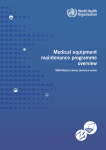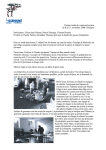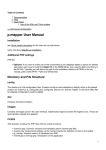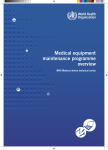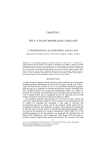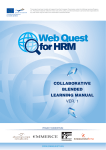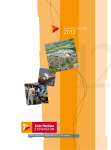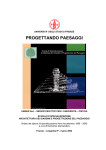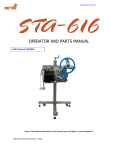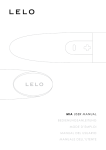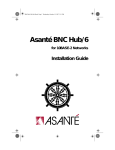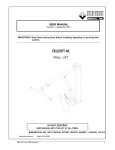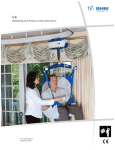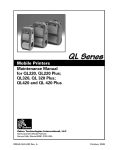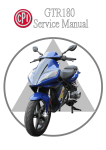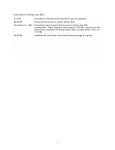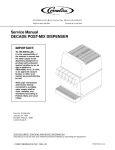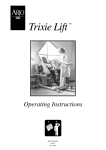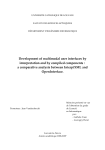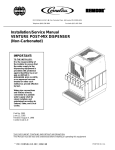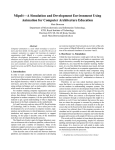Download V4 Ceiling Lift TECHNICAL DOCUMENTATION
Transcript
V4 serie Technical file LIFTING DEVICES FOR PERSONS V4 Ceiling Lift By 2001 Tanguay Street Magog, Quebec, Canada J1X 5Y5 Tel.: (819) 868-0441 Fax: (819) 868-2249 TECHNICAL DOCUMENTATION 2001 Tanguay Street Magog, Quebec, Canada J1X 5Y5 Tel.: (819) 868-0441 Fax: (819) 868-2249 Revised: August 2003 1 V4 serie Technical file Technical file content 1 Introduction ________________________________________________________________________________________4 1.1 Product identification_____________________________________________________________________________4 1.2 Manufacturer and location_________________________________________________________________________4 1.3 Subcontractors and location________________________________________________________________________4 2 Standards procedure _________________________________________________________________________________5 2.1 CE Marking procedure ___________________________________________________________________________5 2.1.1 Route of compliance _________________________________________________________________________5 2.1.2 Declaration of conformity _____________________________________________________________________5 2.1.3 National and European device classification (annex IX) ______________________________________________5 2.2 European Directives and Standards: _________________________________________________________________5 2.2.1 Directive Medical Devices 93/42/EEC ___________________________________________________________5 2.2.2 Directive 73/23/EEC Electrical Equipment ________________________________________________________5 2.2.3 European Standard: 89/336/EEC ________________________________________________________________5 2.2.4 Risk Analysis (EN 1441 for Europe): security and performance________________________________________6 2.3 Authorized European Union representation____________________________________________________________6 2.4 Specific standards _______________________________________________________________________________6 2.4.1 ISO 10535 _________________________________________________________________________________6 2.4.2 CSA 601.1 (EN 60601.1, UL 2601.1) ____________________________________________________________6 2.4.3 CSA Z323.5-1998 ___________________________________________________________________________6 2.5 Lifetime of products _____________________________________________________________________________6 2.6 Quality Assurance, procedures and certificate__________________________________________________________7 2.7 Post-Market Surveillance__________________________________________________________________________7 2.7.1 Complaints and incidents reported_______________________________________________________________7 3 2.7.2 Advisory notices and recalls ___________________________________________________________________7 2.7.3 Competent authorities ________________________________________________________________________7 Description of Product________________________________________________________________________________8 3.1 General Description ______________________________________________________________________________8 3.1.1 Description of product ________________________________________________________________________8 3.1.2 Parts description____________________________________________________________________________10 3.1.3 Dimensions _______________________________________________________________________________10 3.1.4 Definition of product family __________________________________________________________________12 3.1.5 Functional purpose of the device (intended use) ___________________________________________________12 3.1.6 Variants of the device _______________________________________________________________________12 3.1.7 Records of significant changes to the device design ________________________________________________12 3.2 Use information ________________________________________________________________________________12 3.2.1 Advertising/Warning ________________________________________________________________________12 3.2.2 Intended patient population and medical condition _________________________________________________12 3.2.3 The reasonably foreseeable medical conditions is not be used ________________________________________12 3.3 Market information _____________________________________________________________________________13 3.3.1 Warranty _________________________________________________________________________________13 3.3.2 Photograph of product and use ________________________________________________________________14 3.3.3 Brochure, advertising, marketing claims _________________________________________________________14 3.3.4 Packaging specifications, transport and storage conditions ___________________________________________14 2 V4 serie Technical file 4 3.3.5 Details of product labelling, instructions for use and other literature ___________________________________14 3.3.6 User and Technical Manuals __________________________________________________________________14 Product Specification________________________________________________________________________________15 4.1 General description of each of the functional parts/components ___________________________________________15 4.1.1 Bill of Materials____________________________________________________________________________15 4.1.2 Mechanism________________________________________________________________________________15 4.1.3 Accessories and other devices or equipment ______________________________________________________16 4.1.4 Functional characteristics and technical specifications for the device___________________________________16 4.2 General Description of electrical components: ________________________________________________________17 4.2.1 Technical specifications of batteries ____________________________________________________________17 4.2.2 Technical specifications of charger _____________________________________________________________18 4.2.3 Technical specifications of motors _____________________________________________________________19 4.2.4 Control circuit plans ________________________________________________________________________20 4.3 Design and production documentation ______________________________________________________________20 4.3.1 Calculation notes-scoop of work _______________________________________________________________20 5 4.3.2 Bibliography and references __________________________________________________________________20 4.3.3 Material safety data description and physical properties of the materials ________________________________20 4.3.4 Specifications, instructions and fabrication process ________________________________________________20 4.3.5 Special process instructions and inspections ______________________________________________________20 Verification of product ______________________________________________________________________________21 5.1 Test records: __________________________________________________________________________________21 5.1.1 Internal, laboratory and engineering tests ________________________________________________________21 5.1.2 Records, methods and tests localization _________________________________________________________21 Appendix 2.1.2: Directive 93/42/EEC Annex VII______________________________________________________________22 Appendix 2.1.3: CE Declaration of conformity________________________________________________________________24 Appendix 2.1.4: Directive 93/42/EEC Annex IX ______________________________________________________________25 Appendix 2.2.1. Directive 93/42/EEC Annex I Essential requirements _____________________________________________28 Appendix 2.2.2: Directive 73/23/EEC_______________________________________________________________________34 Appendix 2.2.3 a): Directive 89/336/EEC: ___________________________________________________________________35 Appendix 2.2.3 b): Standard EN 12182______________________________________________________________________36 Appendix 2.2.4: Standard EN 1441 Risk Analysis _____________________________________________________________38 Appendix 2.5.2 a) CSA Certificate V4 ______________________________________________________________________43 Appendix 2.5.2 b) CSA Report V4 _________________________________________________________________________46 Appendix 2.6: SGS Certificate ISO 9001-1994________________________________________________________________68 Appendix 2.7.3: National authority _________________________________________________________________________69 Appendix 3.1.4: Identical models __________________________________________________________________________72 Appendix 3.2.1 Extract of safety instructions, advertisings and warnings ___________________________________________73 Appendix 3.3.3 Brochure, advertising, marketing claims _____________________________________________________78 Appendix 4.1.1 : V4 part list ______________________________________________________________________________82 Appendix 4.1.3 a): Accessories ____________________________________________________________________________87 Appendix 4.1.3 b): Slings ________________________________________________________________________________89 Appendix 4.1.3 c) KWIKtrak ____________________________________________________________________________111 3 V4 serie Technical file 1 1.1 Introduction Product identification General names: Serial name: Family name 1.2 420PLUS / V4 Voyager Ceiling lift Manufacturer and location BHM Medical Inc 2001 Tanguay Street Magog, Quebec, Canada, J1X 5Y5 How to contact us (North America): BHM Medical Inc. 2001 Tanguay Street Magog (Quebec) Canada J1X 5Y5 Phone: (819) 868-0441 ? service calls during business hours (8:00-12:00 and 1:00-5:00 p.m. E.S.T.) ? service calls outside regular business hours Extension #6199 (you must press the pound key) Fax: (819) 868-2249 Web site: www.bhm-medical.com E-mail: [email protected] 1.3 Subcontractors and location BHM Medical designs all parts in Quebec, Canada, except of batteries and motor Subcontractors manufacture majority of parts in Quebec, Canada. Elvi manufactures motor in Italy. Batteries and some electronic parts are manufactured in Asia. For more information, see annex 2.5.2 b) BHM Medical assembles lift and accessories in Quebec, Canada. More information on suppliers and subcontractors are available. 4 V4 serie Technical file 2 2.1 Standards procedure CE Marking procedure 2.1.1 Route of compliance According to the Council Directive 93/42/EEC Article 11.5 “The manufacturer shall, in order to affix the CE marking, follow the procedure referred to in Annex VII and draw up the EC declaration of conformity required before placing the device on market”. Class I EC Declaration of Conformity (Annex VII) Quality Assurance (Clinical investigation or custom-made) No applicable CE Mark 2.1.2 Declaration of conformity See annex 2.1.2: Declaration of conformity 2.1.3 National and European device classification (annex IX) See annex 2.1.3: Directive 93/42/EEC annex IX 2.2 European Directives and Standards: 2.2.1 Directive Medical Devices 93/42/EEC See annex 2.2.1: Directive 93/42/EEC Annex I Essential Requirements 2.2.2 Directive 73/23/EEC Electrical Equipment See annex 2.2.2: Directive 73/23/EEC Annex 1 2.2.3 European Standard: 89/336/EEC See annex 2.2.3: Directive 89/336/EEC 5 V4 serie Technical file 2.2.4 Risk Analysis (EN 1441 for Europe): security and performance See annex 2.2.4: Risk Analysis 2.3 Authorized European Union representation BHM Medical general representative for Europe: EHS European Healthcare Solutions 14 Cross Street. Barnes London SW13 0PS United Kingdom BHM Medical authorized distributors for Europe (partial list): Sunrise Medical Ltd High Street Wollaston West Midlands DY8 4PS England RMT Reha Med Technology 63322 RODERMARK Germany 2.4 Specific standards 2.4.1 ISO 10535 Test report available. 2.4.2 CSA 601.1 (EN 60601.1, UL 2601.1) See appendix 2.4.2 a) CSA Certificate of Compliance V4 See appendix 2.4.2 b) CSA report V4 2.4.3 CSA Z323.5-1998 Test report available. 2.5 Lifetime of products These product are designed, manufactured and tested for a lifetime corresponding at 10 000 cycles of use. The mechanism shall be maintained according to manufacturer instructions. The lifetime of batteries depend on the duty cycle of use, see “Technical specifications of batteries” section 4.2.1. The lifetime may be more if a general maintenance and inspection, according to the manufacturer instructions, at 10 000 cycles permit this. 10 000 cycles usually correspond at 3 years of normal use. 6 V4 serie Technical file 2.6 Quality Assurance, procedures and certificate See annex 2.6: SGS Certificate of ISO 9001-1994 accreditation. 2.7 Post-Market Surveillance 2.7.1 Complaints and incidents reported Available at BHM Medical. 2.7.2 Advisory notices and recalls Available at BHM Medical. 2.7.3 Competent authorities See annex 2.7.3: Competent authorities for Europe 7 V4 serie Technical file 3 3.1 Description of Product General Description 3.1.1 Description of product TRACK LIFT SPECIFICATIONS V4 CHARACTERISTICS * Weight – kg * Lifting capacity – kg * Soft start & stop movement 11.5 kg (batteries include) 200 kg (440 lbs.) YES SAFETY FEATURES * Emergency lowering device * Current limiter & emergency stopping device * Emergency brake Manual & electric YES Centrifugal TECHNICAL SPECIFICATIONS * CSA, UL & CE approved & respect EMI standards * Frame * Vertical displacement speed * Vertical axis motor * Horizontal displacement speed * Horizontal programmable speeds * Horizontal axis motor YES Steel, 1000kg tested 60 mm/sec, (40mm/s at 200kg) 24 VDC, 1/12 HP 150 mm/s 100mm/s, 150mm/s, 200mm/s, 250mm/s 24 VDC, 1/12 HP BATTERY MODEL SPECIFICATIONS * Rechargeable sealed lead acid * Clip on charging system * Battery autonomy with load of 75 kg ) Up to 100 transfers * Visual & audible low battery indicator YES * Battery protection function YES * Charge input * Lift cannot return to charger with load YES * Return to charge function on handset Optional 2X12VDC, 4.5Ah YES 0.5 A max, 100 to 240 Vac, 50 to 60 HZ STRAP SPECIFICATIONS * Length * Automatically stops unit if twisted 2.3 m, 1500kg tested YES UNIT COMPOSITES * Mechanical structure – high strength steel YES, 1000kg tested 8 V4 serie Technical file * Dimensions * Cab –VO plastic – fire retardant YES * Rail –T66081-T5 high extruded aluminium & baked paint coated. YES Length 38 cm, Width 25 cm, Height 18 cm DESCRIPTION OF EQUPMENT – V4 Lift Unit The lift unit is a steel frame based system driven by a gear reduced high torque motor. OPERATING FEATURES : Lifting capacity : 200 kg (440 lbs). Average weight: 11,5 kg (25 lbs) batteries included. Electronic soft-start and soft-stop motor control. Emergency lowering device Emergency stopping device. Current limiter for circuit protection in case of overload. Safety device that stops the motor to lift when batteries are too low. Lifting speed : 6 cm/s (2.3in/s), 3.5cm/s (1.6in/s) in full capacity. Horizontal displacement speeds : 10, 15, 20 and 25 cm/s. Speed by default 20cm/s (6in/s). Horizontal axis motor : 24VDC at 62 watts and vertical axis motor at 110w. Emergency brake (in case of mechanical failure). Operates on the same principle as a car safety belt mechanism. Strap length up to 2.3m (90in) tested for 1360kg (2998). CSA No. 601.1, UL No 2601-1 and CE conformity. Respect EMI standards ISO 10535. What’s included ITEM QTY V4 Lift 1 Batteries (inside unit) 2 Clip on charging station 1 Hand control 1 Spreader bar 1 Power cord 1 8 mm Allen key 1 User Manual 1 9 V4 serie Technical file 3.1.2 Parts description 3.1.3 Dimensions (In millimetres) 10 V4 serie Technical file TOTAL STRAP LENGTH 11 Voyager Portable Technical File 3.1.4 Definition of product family Family: Voyager Ceiling Lift: Voyager: Lift: Ceiling: BHM serial name (trade mark) Equipment for transferring by lifting and moving a disabled person in an area limited by the system. Stationary hoists using a ceiling support, a ceiling rail or a freestanding support. 3.1.5 Functional purpose of the device (intended use) Lifting and moving a disabled person. 3.1.6 Variants of the device Voyager 420PLUS or V420PLUS Name: The trade name “Voyager V420PLUS” or “V420PLUS” is used in some parts of North-America. The major difference is the safe working load indicated on V420PLUS is 190kg/420lbs for reason commercial only. Conception and fabrication: All Voyager 420PLUS have the same conception and fabrication for mechanism and control than V4. The most frequent variation is optional features and cabin. 3.1.7 Records of significant changes to the device design No major modification was made to the product. None are concerning critical, safety or subjected part to the standards. 3.2 Use information 3.2.1 Advertising/Warning See annex 3.3.1: Advertising (more advertising available in user manual). 3.2.2 Intended patient population and medical condition For handicapped, disabled, people in loss of independence and senior citizen without wound. 3.2.3 The reasonably foreseeable medical conditions is not be used People with wound or spasm (medical guidance), People without muscular tonus (vigilance and precaution). 12 Voyager Portable Technical File 3.3 Market information 3.3.1 Warranty WARRANTY (extract) This warranty is extended only to the original purchaser/user of BHM products. BHM Medical Inc. warrants its products to be free from defects in material under normal use and service, within the periods stated below from the date of purchase. If within such warranty period any such product shall be proven to be defective, such product shall be repaired or replaced at BHM Medical’s option. This warranty does not include any labour or shipping charges incurred in replacement part installation or repair of any such product. BHM Medical’s sole obligation and your exclusive remedy under this warranty shall be limited to such repair and/or replacement. Patient Lifter Tracks and installation Weighing Devices Accessories on Lifter Slings Batteries - All other lifts Easytrack System 1 year Life time warranty* 1 year 1 year 1 year 1 year 1 year For warranty service, please contact the dealer from whom you purchased the BHM Medical product. [In the event that you do not receive satisfactory warranty service, please contact BHM Medical (see contact information in Table of Contents).] Do not return products to our factory without prior authorization. BHM Medical will issue a Return Merchandise Authorization (RMA) Number. C.O.D. shipments will be refused; all shipments to BHM Medical must be prepaid. For this warranty to be valid, the purchaser must present its original proof of purchase at the moment of the claim. The defective unit, assembly or part must be returned to BHM Medical for inspection. The part or components repaired or replaced are guaranteed for the remaining period of the initial warranty. Limitations and Exclusions: The warranty above does not apply to serial numbered products if the serial number has been removed or defaced. No warranty claim shall apply where the product or any other part thereof has been altered, varied, modified, or damaged; either accidentally or through improper or negligent use and storage. Warranty does not apply to products modified without BHM Medical’s express written consent, (including but not limited to products modified with unauthorized parts or attachments); products damaged by reason of repairs made to any component without the specific consent of BHM Medical, or to products damaged by circumstances beyond BHM Medical’s control. BHM Medical will solely determine evaluation of warranty claim. The warranty does not apply to problems arising from normal wear or failure to adhere to the instructions in this manual. BHM Medical Inc. slings are void of warranty if not laundered as per instructions on the Sling Label. BHM Medical Inc. shall not be liable for damages losses or inconveniences caused by a carrier. This warranty replaces any other warranty expressed or implicit and constitutes BHM Medical Inc. only obligation towards the purchaser. BHM Medical shall not be liable for any consequential or incidental damages whatsoever. * Valid only if BHM Medical did the original installation. Guarantee void if tracks/installation have been modified. 13 Voyager Portable Technical File 3.3.2 Photograph of product and use See also user and technical manuals. 3.3.3 Brochure, advertising, marketing claims See annex 3.3.3 Also available at BHM Medical or ask your local representative. 3.3.4 Packaging specifications, transport and storage conditions Duration: Not exceeding 15 weeks for transport and storage. Handling: Do not drop de product. Environmental conditions: Ambient temperature range of –40°C to +70°C Relative humidity range of 10% to 100% Atmospheric pressure range of 50 to 106 Kpa BHM Medical recommends charging of batteries at least every two weeks even if the lift is not used. This will prevent premature aging of batteries. 3.3.5 Details of product labelling, instructions for use and other literature Ask your local representative for national specific labelling. 3.3.6 User and Technical Manuals See your local representative for national version. 14 Voyager Portable Technical File 4 Product Specification 4.1 General description of each of the functional parts/components 4.1.1 Bill of Materials See annex 4.1.1 4.1.2 Mechanism Model consists of a 24Vdc battery operated patient lifter module installed on a rail. All components are enclosed in on-combustible enclosure without ventilation opening. Lifter can be displaced manually or it is moved by a motor on the rail. Flame class rating for both plastic parts white and blue (plastic cab): Material: V-0 Class Rating Test method: UL 94 All electrical parts are enclosed in non-combustible V-0 plastic enclosure and metal chassis without ventilation opening. Emergency Switch S5 Certified CSA*/UR* type pullchain switch. DC Motor (vertical movement): Manufaturer: ELVI MOTORI ELETTRICI SRL Type: Fully enclosed, no ventilation opening permanent magnet, class A Rating: 24Vdc, 1.1A, 110W, 4000RPM, 0.3N-m Mounting: Secured by screws and lock-washer to chassis. DC Motor (Horizontal movement): Manufaturer: ELVI MOTORI ELETTRICI SRL Type: Fully enclosed, no ventilation opening permanent magnet, provided with integral reducer Rating: 24Vdc, 1.8A, 30W, 260RPM, 1.0N-m Mounting: Secured by screws and lock-washer to chassis. Frame: Frame is made of steel, 2.64mm thick. The structure forms a box, 164mm x 140mm wide by 124mm high. Other mechanical parts are fixed to this frame. The frame and steel parts are protected against rust by a zinc plated treatment. Aluminium parts are protected by “heredite” or “anodize” plated treatment. Displacement: Strap: Vertical (up/down), drum The motor (ELVI without gearbox) drives a 30 teeth worm gear, double tread. The worm gear drives a shaft on which lies a worm. This worm drives a second worm gear directly attached to the drum. The total obtained ratio is 375:1. The strap is a threaded nylon that can hold up to 2727kg (6000lbs). Section: 49mm x 1.2mm thick. Displacement: Horizontal (left/right). The motor (ELVI with integrated gear box) drives a spur gear that drives two idlers. Those idlers directly drive the wheel. The wheels are made of plastic over-molded on ball bearings. Wheels are fixed on trolley with spring pins. Steel trolley is fixed to the frame by three interlocks and secured with another interlock and a M5 screw. 15 Voyager Portable Technical File End of strap stopper: (Up/down) In the unit, a limit switch is attached on a steel blade, sensing the double thickness of the strap. This indicateds the higher position of the strap. The lower limit is sensed when the drum tries to roll the strap into the wrong direction. This will activate the switch and stops the motor. 4.1.3 Accessories and other devices or equipment See annex 4.1.3 4.1.4 Functional characteristics and technical specifications for the device HOW A VOYAGER SERIES IMPROVES EFFICIENCY AND CARE Emergency Stop (Red Cord) The emergency stop can be activated at any time to stop the functioning of the lift. Emergency Lowering Feature In the event of an electrical or functional failure, the V4 has an emergency manual lowering feature. If the lift malfunctions when a patient is being transferred, the emergency lower device provices a safe way of lowering the patient onto a chair or a bed. Emergency Brake The emergency brake is made of a metal bar fixed to the drum. 16 Voyager Portable Technical File In case of gear or motor breakage, the centrifugal force created will block the bar against the frame. Programmable Lift Mode Program The speed and height of the lift can be easily adjusted by the user while in the Program « Service » Mode. Use the « UP » button on the hand control to select the parameters wanted. Each push of the button will bring you to a different selection : 4.2 1 beep = Speed displacement 2 beeps = Length of the strap General Description of electrical components: 4.2.1 Technical specifications of batteries 2 rechargeable batteries of 12 Vdc, 5 Ah. Provides up to 120 transfers with a load of 74kg (200lb.) and up to 70 transfers with its maximum load of 200kg (440lb). Life cycle (number of charging cycles) of the batteries is largely dependant on the depth of discharge in each cycle. More the batteries are drained, the shorter their life span. The lifte of the batteries is also related to such factors as varying temperatures and rest periods between charge and discharge. Graph 1 illlustrates the relationship between the discharging depth and expected battery life. 17 Voyager Portable Technical File If you drain the batteries until they beep every time, you can expect the batteries to fully charge only 600 times. . Indicator Lights The lift and the charging system have many indicator lights. It important to understand their significance for use and comprehension of the lift. Green light Operating the lift ----------Low batteries The lift is on and ready to use. Yellow light States of batteries ----------In process of charging batteries Charging done, batteries charged. Red light Maintenance ----------Maintenance required by your local representative Lift started by service mode Charging indicator green light Clip on charging station indicator green light Turn on Charger on Turn on Clip on charging station on. 4.2.2 Technical specifications of charger Charger input : 100-240 Vac, 50/60 Hz. Charger output : 27 Vdc, 1 A max. Charger clip on the rail. Charging station clip on the rail. See appendix 2.4.2 b) for more details. 18 Voyager Portable Technical File 4.2.3 Technical specifications of motors DC Motor (vertical movement) Manufacturer : Type : Part # : Rating : Overall dim. : Mounting : ELVI Fully enclosed, no ventilation opening, permanent magnet, without gearbox. 100.462/FC (BHM Part number = #400.14000) 24 Vdc, 1.1A, 110 Watts, 4000 RPM, 0.3 N-m ø77mm x 131.5mm long (without worm shaft) Secured by screws and lockwasher to chassis. A) Rotor : Mounting : Laminated steel, 55 mm dia by 38 mm high Crimp to the shaft B) Rotor Winding : Enamelled copper wire, class H- UL (see enclosed sheet) C) Rotor to winding insulation : D) Spacer material : F) Collector : Copper 23 diam. long, (see enclosed sheet) G) Brush : Dimensions : Carbon composition mounted on spring 5 x 8 x 12 mm H) Brush holder : Later 4 G/30 (see enclosed sheet) I) Motor leads : connector. J) Motor leads connection to windings : 1 layer of Isotherm, 0.25 mm thick, Class F 145°C PSU 2010 (see enclosed sheet) Certified, TEW 105°C, N° 18AWG, connected by certified 2 pins AMP crimping DC Motor (horizontal movement) Manufacturer : Type : Part # : Rating : Overall dim. : Mounting : ELVI Fully enclosed, no ventilation opening, permanent magnet, with integral reducer. 101.663/FC (BHM Part number = #E0006) 24 Vdc, 1.8A, 30 Watts, 260 RPM, 1.0 N-m ø63mm x 114mm long (without reducer) Secured by screws and lockwasher to chassis. A) Rotor : Mounting : Laminated steel, 42 mm dia by 32 mm high Crimp to the shaft B) Rotor Winding : Enamelled copper wire, class H- UL (see enclosed sheet) D) Rotor to winding insulation : D) Spacer material : F) Collector : Copper 19 mm diam. (see enclosed sheet) G) Brush : Dimensions : Carbon composition mounted on spring 6.5x4.5x10 mm 1 layer of Isotherm, 0.25 mm thick, Class F 145°C PSU 2010 (see enclosed sheet) 19 Voyager Portable Technical File K) Brush holder : Later 4 G/30 (see enclosed sheet) L) Motor leads : connector. M) Motor leads connection to windings : Certified, TEW 105°C, N° 18AWG, connected by certified 2 pins AMP crimping 4.2.4 Control circuit plans See CSA report in appendix 2.4.2 b) 4.3 Design and production documentation 4.3.1 Calculation notes-scoop of work Available 4.3.2 Bibliography and references Available 4.3.3 Material safety data description and physical properties of the materials Available 4.3.4 Specifications, instructions and fabrication process Available 4.3.5 Special process instructions and inspections Available 20 Voyager Portable Technical File 5 Verification of product BHM Medical Inc. Credentials FDA Registration # 9681684 CE mark (European Union Listing) Each finished Voyager Portable is individually tested in our laboratory. Lifting Capacity 200 kg/440 lbs. Engineering safety factor exceeds European Standards. Complete range of patient lift slings and supports designed and manufactured by BHM Medical Inc. using medical quality materials and fabrics. ISO 9001 Voyager is a registered trademark of BHM Medical Inc. APPROVALS: CSA 601.1 UL 2601.1 EN 60601.1 5.1 Test records: 5.1.1 Internal, laboratory and engineering tests Internal conception and development information are available 5.1.2 Records, methods and tests localization See section 2 for certificates and reports. 21 Voyager Portable Technical File Appendix 2.1.2: Directive 93/42/EEC Annex VII Directive 93/42/CEE Concerning Medical Devices (June 1994) Annex VII: Declaration of Conformity Product: V4 Clause 2 3 4 Requirement The manufacturer must prepare the technical documentation described in Section 3. The manufacturer or his authorized representative established in the Community must make this documentation, including the declaration of conformity, available to the national authorities for inspection purposes for a period ending at least five years after the last product has been manufactured. The technical documentation must allow assessment of the conformity of the product with the requirements of the Directive. It must include in particular: - A general description of the product, including any variants planned, - Design drawings, methods of manufacture envisaged and diagrams of components, sub-assemblies, circuits, etc., - The descriptions and explanations necessary to understand the above mentioned drawings and diagrams and the operations of the product, - The results of the risk analysis and a list of the standards referred to in Article 5, applied in full or in part, and descriptions of the solutions adopted to meet the essential requirements of the Directive if the standards referred to in Article 5 have not been applied in full, - In the case of products placed on the market in a sterile condition, description of the methods used, - The results of the design calculations and of the inspections carried out, etc.; if the device is to he connected to other device(s) in order to operate as intended, proof must he provided that it conforms to the essential requirements when connected to any such device(s) having the characteristics specified by the manufacturer, - The test reports and, where appropriate, clinical data in accordance with Annex X, - The label and instructions for use. The manufacturer shall institute and keep up to date a systematic procedure to review experience gained from devices in the postproduction phase and to implement appropriate means to apply any necessary corrective actions, taking account of the nature and risks in relation to the product. He shall notify the competent authorities of the following incidents immediately on learning of them: - Any malfunction or deterioration in the characteristics and/or performance of a device, as well as any inadequacy in the labelling or the instructions for use which might lead to or might have led to the death of a patient or user or to a serious deterioration in his stare of health; - Any technical or medical reason connected with the Notes Verdict Yes Yes Yes Yes Requirements of EN 1441 Risks analysis applied Yes N/A Yes Procedure previous Yes Yes Yes 22 Voyager Portable Technical File 5 6.1 characteristics on the performance of a device for the reasons referred to in subparagraph (I) leading to systematic recall of devices of the same type by the manufacturer. With products placed on the market in sterile condition and Class I devices with a measuring function, the manufacturer must observe not only the provisions laid down in this Annex but also one of the procedures. Where this Annex is applied in conjunction with the procedure referred to in Annex IV, V or VI, the declaration of conformity referred to in the abovementioned Annexes forms a single declaration. As regards the declaration based on this Annex, the N/A Yes manufacturer must ensure and declare that the product design meets the provisions of this Directive which apply to it. This text don’t reproduce the directive but to do refer at this 23 Voyager Portable Technical File Appendix 2.1.3: CE Declaration of conformity 24 Voyager Portable Technical File Appendix 2.1.4: Directive 93/42/EEC Annex IX Directive 93/42/EEC Concerning Medical Devices (June 1994) Annex IX: CLASSIFICATION CRITERIA Product: V4 III. Classification Rules 1.1 # 1 1.2 2 1.3 3 1.4 4 2.1 5 2.2 6 Devices concerned All non-invasive devices are in Class I, unless one of the rules set out hereinafter applies. All non-invasive devices intended for channelling or storing blood, body liquids or tissues, liquids or gases for the purpose of eventual infusion, administration or introduction into the body are in Class IIa: - If they may be connected to an active medical device in Class IIa or a higher class, - If they are intended for use for storing or channelling blood or other body liquids or for storing organs, parts of organs or body tissues, In all other cases they are in Class 1. All non-invasive devices intended for modifying the biological or chemical composition of blood, other body liquids or other liquids intended for infusion into the body are in Class llb, unless the treatment consists of filtration, centrifugation or exchanges of gas, heat, in which case they are in Class IIa. All non-invasive devices which come into contact with injured skin: - Are in Class I if they are intended to be used as a mechanical barrier, for compression or for absorption of exudates, - Are in Class Ilb if they are intended to be used principally with wounds which have breached the dermis and can only heal by secondary intent, - Are in Class Ila in all other cases, including devices principally intended to manage the microenvironment of a wound. All invasive devices with respect to body orifices, other than surgically invasive devices and which are not intended for connection to an active medical device: - Are in Class I if they are intended for transient use, - Are in Class lla if they are intended for short-term use, except if they are used in the oral cavity as far as the pharynx, in an car canal up to the car drum or in a nasal cavity, in which case they are in Class I, - Are in Class IIb if they are intended for long-term use, except if they are used in the oral cavity as far as the pharynx, in an ear canal up to the car drum or in a nasal cavity and are not liable to be absorbed by the mucous membrane, in which case they are in Class IIa. All invasive devices with respect to body orifices, other than surgically invasive devices, intended for connection to an active medical device in Class lla or a higher class, are in Class IIa. All surgically invasive devices intended for transient use are in Class lIa unless they arc: - Intended specifically to diagnose, monitor or correct a defect of the heart or of the central circulatory system through direct contact with these parts of the body, in which case they are in Class III, - Reusable surgical instruments, in which case they are in Class I, - Intended to supply energy in the form of ionizing radiation in which case they are in Class llb, - Verdict Class 1 Applied Class 1 Applied N/A Non invasive Non invasive Non invasive Intended to have a biological effect or to he wholly or mainly absorbed in which case they are in Class IIb, 25 Voyager Portable Technical File - 2.3 7 2.4 8 3.1 9 3.2 3.2 10 11 Intended to administer medicines by means of a delivery system, if this is done in a manner that is potentially hazardous taking account of the mode of application, in which they are in Class IIb. All surgically invasive devices intended for short-term use are in Class IIa unless they are intended: - Either specifically to diagnose, monitor or correct a defect of the heart or of the central circulatory system through direct contact with these parts of the body, in which case they are in Class III, - Or specifically for use in direct contact with the central nervous system, in which case they are in Class III, - Or to supply energy in the form of ionizing radiation in which case they are in Class Ibis, - Or to have a biological effect or to be wholly or mainly absorbed in which cast they are in Class III, - Or to undergo chemical change in the body, except if the devices are placed in the teeth, or to administer medicines, in which case they are in Class lIb. All implantable devices and long-term surgically invasive devices are in Class IIb unless they are intended: - To be placed in the teeth, in which cast they are in Class Ila, - To be used in direct contact with the heart, the central circulatory system or the central nervous system, in which case they are in Class Ill, - To have a biological effect or to be wholly or mainly absorbed, in which cast they are in Class Ill, - Or to undergo chemical change in the body, except if the devices are placed in the teeth, or to administer medicines, in which case they are in Class 111. All active therapeutic devices intended to administer or exchange energy are in Class lIa unless their characteristics are such that they may administer or exchange energy to or from the human body in a potentially hazardous way, taking account of the nature, the density and site of application of the energy, in which cast they are in Class lIb. All active devices intended to control or monitor the performance of active therapeutic devices in Class IIb, or intended directly to influence the performance of such devices are in Class llb. Active devices intended for diagnosis are in Class IIa: - If they are intended to supply energy which will be absorbed by the human body, except for devices used to illuminate the patient's body, in the visible spectrum, - If they are intended to image in vivo distribution of radiopharrnaceuticals, - If they are intended to allow direct diagnosis or monitoring of vital physiological processes, unless they are specifically intended for monitoring of vital physiological parameters, where the nature of variations is such that it could result in immediate danger to the patient, for instance variations in cardiac performance, respiration, activity of CNS in which case they are in Class IIb. Active devices intended to emit ionizing radiation and intended for diagnostic and therapeutic interventional radiology including devices which control or monitor such devices, or which directly influence their performance, are in Class lIb. All active devices intended to administer and/or remove medicines, body liquids or other substances to or from the body are in Class lIa, unless this is done in a manner: - That is potentially hazardous, taking account of the nature of the substances involved, of the part of the body concerned and of the mode of Non invasive N/A Non active Non active Non active 26 Voyager Portable Technical File application in which case they are in Class IIb. All other active devices are in Class I. 3.3 12 Non active N/A 4.1 13 All devices incorporating, as an integral part, a substance which, if used separately, can he considered to be a medicinal product, as defined in Article 1 of Directive 65165/EEC, and which is liable to act on the human body with action ancillary to that of the devices, are in Class Ill. 4.2 14 All devices used for contraception or the prevention of the transmission of sexually transmitted diseases are in Class lIb, unless they are implantable or long term invasive devices, in which case they are in Class III. N/A 4.3 15 All devices intended specifically to be used for disinfecting, cleaning, rinsing or, when appropriate, hydrating contact lenses are in Class IIb. N/A All devices intended specifically to be used for disinfecting medical devices are in Class IIa. 4.4 16 4.5 17 5 18 This rule does not apply to products that are intended to clean medical devices other than contact lenses by means of physical action. Non-active devices specifically intended for recording of X-ray diagnostic images are in Class Ila. All devices manufactured utilizing animal tissues or derivatives rendered nonviable are Class 111 except where such devices are intended to come into contact with intact skin only. By derogation from other rules, blood bags are in Class Ilb. N/A N/A N/A No other rules supersede de rule 1 and 2 than the device is Class 1. This text don’t reproduce the directive but to do refer at this 27 Voyager Portable Technical File Appendix 2.2.1. Directive 93/42/EEC Annex I Essential requirements Directive 93/42/EEC Concerning Medical Devices (June 1994) Annex I: ESSENTIAL REQUIREMENTS Product: V4 Clause 1 2 3 4 5 6 Requirements I General requirements The devices must be designed and manufactured in such a way that, when used under the conditions and for the-purposes intended, they will not compromise the clinical condition or the safety of patients, or the safety and health of users or, where applicable, other persons, provided that any risks which may be associated with their use constitute acceptable risks when weighed against the benefits to the patient and are compatible with a high level of protection of health and safety. The solutions adopted by the manufacturer for the design and construction of the devices must conform to safety principles, taking account of the generally acknowledged state of the art. In selecting the most appropriate solutions, the manufacturer must apply the following principles in the following order: - Eliminate or reduce risks as far as possible (inherently safe design and construction), - Where appropriate take adequate protection measures including alarms if necessary, in relation to risks that cannot be eliminated, - Inform users of the residual risks due to any shortcomings of the protection measures adopted. The devices must achieve the performances intended by the manufacturer and be designed, manufactured and packaged in such a way that they are suitable for one or more of the functions referred to in Article 1 (2) (a), as specified by the manufacturer. The characteristics and performances referred to in Sections 1, 2 and 3 must not be adversely affected to such a degree that the clinical conditions and safety of the patients and, where applicable, of other persons are compromised during the lifetime of the device as indicated by the manufacturer, when the device is subjected to the stresses which can occur during normal conditions of use. The devices must be designed, manufactured and packed in such a way that their characteristics and performances during their intended use will not be adversely affected during transport and storage taking account of the instructions and information provided by the manufacturer. Any undesirable side effect must constitute an acceptable risk when weighed against the performances intended. II. REQUIREMENTS REGARDING DESIGN AND CONSTRUCTION Notes Verdict Requireme nts of EN 1441 Risks analysis applied Yes Requireme nts of EN 1441 Risks analysis applied Yes Yes Yes Yes Requireme nts of EN 1441 Risks analysis applied OK OK Yes 7 Chemical, physical and biological properties 7.1 The devices must be designed and manufactured in such a way as to guarantee the characteristics and performances referred to in Section I on the 'General requirements'. Particular attention must be paid to: - The choice of materials used, particularly as regards toxicity Requireme nts of EN 1441 Risks analysis applied 28 Voyager Portable Technical File and, where appropriate, flammability, The compatibility between the materials used and biological tissues, cells and body fluids, taking account of the intended purpose of the device. The devices must be designed, manufactured and packed in such a way as to minimize the risk posed by contaminants and residues to the persons involved in the transport, storage and use of the devices and to the patients, taking account of the intended purpose of the product. Particular attention must be paid to the tissues exposed and to the duration and frequency of exposure. The devices must be designed and manufactured in such a way that they can be used safely with the materials, substances and gases with which they enter into contact during their normal use or during routine procedures; if the devices are intended to administer medicinal products they must be designed and manufactured in such a way as to be compatible with the medicinal products concerned according to the provisions and restrictions governing these products and that their performance is maintained in accordance with the intended use Where a device incorporates, as an integral part, a substance which, if used separately, may be considered to be a medicinal product as defined in Article 1 of Directive 65/65/EEC and which is liable to act upon the body with action ancillary to that of the device, the safety, quality and usefulness of the substance must be verified, taking account of the intended purpose of the device, by analogy with the appropriate methods specified in Directive 75/318/EEC. The devices must be designed and manufactured in such a way as to reduce to a minimum the risks posed by substances leaking from the device. Devices must he designed and manufactured in such a way as to reduce, as much as possible, risks posed by the unintentional ingress of substances into the device taking into account the device and the nature of the environment in which it is intended to be used. Infection and microbial contamination Construction and environmental properties If the device is intended for use in combination with other devices or equipment, the whole combination, including the connection system must be safe and must not impair the specified performances of the devices. Any restrictions on use must be indicated on the label or in the instructions for use. Devices must be designed and manufactured in such a way as to remove or minimize as far as is possible: - The risk of injury, in connection with their physical features, including the volume/pressure ratio, dimensional and where appropriate ergonomic features, Yes - 7.2 7.3 7.4 7.5 7.6 8 9 9.1 9.2 - - 9.3 The risks connected with reasonably foreseeable environmental conditions, such as magnetic fields, external electrical influences, electrostatic discharge, pressure, temperature or variations in pressure and acceleration, The risks of reciprocal interference with other devices normally used in the investigations or for the treatment given, The risks arising where maintenance or calibration are not possible (as with implants), from ageing of materials used or loss of accuracy of any measuring or control mechanism. Devices must be designed and manufactured in such a way as to N/A N/A N/A N/A N/A See Risk Analysis Yes N/A See Instruction s manual for use accessories Requireme nts of EN 1441 Risks analysis applied Yes Yes Yes N/A Yes Yes 29 Voyager Portable Technical File 10 11 12 12.1 12.2 minimize the risks of fire or explosion during normal use and in single fault condition. Particular attention must be paid to devices whose intended use includes exposure to flammable substances or to substances which could cause combustion. Devices with a measuring function Protection against radiation Requirements for medical devices connected to or equipped with an energy source Devices incorporating electronic programmable systems must be designed to ensure the repeatability, reliability and performance of these systems according to the intended use. In the event of a single fault condition (in the system) appropriate means should be adopted to eliminate or reduce as far as possible consequent risks. Devices where the safety of the patients depends on an internal power supply must be equipped with a means of determining the state of the power supply. 12.3 Devices where the safety of the patients depends on an external power supply must include an alarm system to signal any power failure. 12.4 Devices intended to monitor one or more clinical parameters of a patient must be equipped with appropriate alarm systems to alert the user of situations which could lead to death or severe deterioration of the patient's state of health. Devices must be designed and manufactured in such a way as to minimize the risks of creating electromagnetic fields which could impair the operation of other devices or equipment in the usual environment. Protection against electrical risks 12.5 12.6 12.7 Devices must be designed and manufactured in such a way as to avoid, as far as possible, the risk of accidental electric shocks during normal use and in single fault condition, provided the devices are installed correctly. Protection against mechanical and thermal risks 1- Devices must be designed and manufactured in such a way as to protect the patient and user against mechanical risks connected with, for example, resistance, stability and moving parts. 2- Devices must be designed and manufactured in such a way as to reduce to the lowest possible level the risks arising from vibration generated by the devices, taking account of technical progress and of the means available for limiting vibrations, particularly at source, unless the vibrations are part of the specified performance. 3- Devices must be designed and manufactured in such a way as to reduce to the lowest possible level the risks arising from the noise emitted, taking account of technical progress and of the means available to reduce noise, particularly at source, unless the noise emitted is part of the specified performance. 4- Terminals and connectors to the electricity, gas or hydraulic N/A N/A Requireme nts of EN 1441 Risks analysis applied Requireme nts of EN 1441 Risks analysis applied Requireme nts of EN 1441 Risks analysis applied Yes Yes Yes N/A CSA C22.2 no601.1 approved Requireme nts of EN 1441 Risks analysis applied Requireme nts of EN 1441 Risks analysis applied Yes Yes Yes Yes Yes 30 Voyager Portable Technical File 12.8 12.9 13 13.1 and pneumatic energy supplies which the user has to handle must be designed and constructed in such a way as to minimize all possible risks. 5- Accessible parts of the devices (excluding the parts or areas intended to supply beat or reach given temperatures) and their surroundings must not attain potentially dangerous temperatures under normal Use. Protection against the risks posed to the patient by energy supplies or substances The function of the controls and indicators must be clearly specified on the devices. Information supplied by the manufacturer Each device must be accompanied by the information needed to use it safely and to identify the manufacturer, taking account of the training and knowledge of the potential users. Yes N/A N/A Yes See labels and manuals Yes Symbols conform with medical standards See labels Yes This information comprises the details on the label and the data in the instructions for use. As far as practicable and appropriate, the information needed to use the device safely must be set our on the device itself and/or on the packaging for each unit or, where appropriate, on the sales packaging. If individual packaging of each unit is not practicable, the information must be set our in the leaflet supplied with one or more devices. 13.2 13.3 Instructions for use must be included in the packaging for every device. By way of exception, no such instructions for use are needed for devices in Class I or IIa if they can be used safely without any such instructions. Where appropriate, this information should take the form of symbols. Any symbol or identification colour used must conform to the harmonized standards. In areas for which no standards exist, the symbols and colours must be described in the documentation supplied with the device. The label must bear the following particulars: a) The name or trade name and address of the manufacturer. For devices imported into the Community, in view of their distribution in the Community, the label, or the outer packaging, or instructions for use, shall contain in addition the name and address of either the person responsible referred to in Article 14 (2) or of the authorized representative of the manufacturer established within the Community or of the importer established within the Community, as appropriate; b) The details strictly necessary for the user to identify the device and the contents of the packaging; c) Where appropriate, the word 'STERILE'; d) Where appropriate, the batch code, preceded by the word 'LOT', or the serial number; e) Where appropriate, an indication of the date by which the device should be used, in safety, expressed as the year and month; f) Where appropriate, an indication that the device is for single use; g) If the device is custom-made, the words 'custom-made device'; h) If the device is intended for clinical investigations, the words 'exclusively for clinical investigations'; Yes Yes N/A N/A N/A N/A N/A N/A 31 Voyager Portable Technical File i) j) k) l) 13.4 13.5 13.6 Any special storage and/or handling conditions; Any special operating instructions; Any warnings and/or precautions to take; Year of manufacture for active devices other than those covered by (c). This indication may be included in the batch or serial number; m) Where applicable, method of sterilization. If the intended purpose of the device is not obvious to the user, the manufacturer must clearly state it on the label and in the instructions for use. Wherever reasonable and practicable, the devices and detachable components must be identified, where appropriate in terms of batches, to allow all appropriate action to detect any potential risk posed by the devices and detachable components. Where appropriate, the instructions for use must contain the following particulars: a) The details referred to in Section 13.3, with the exception of (d) and (c); b) The performances referred to in Section 3 and any undesirable side-effects; c) If the device must he installed with or connected to other medical devices or equipment in order to operate as required for its intended purpose, sufficient details of its characteristics to identify the correct devices or equipment to use in order to obtain a safe combination; d) All the information needed to verify whether the device is properly installed and can operate correctly and safely, plus details of the nature and frequency of the maintenance and calibration needed to ensure that the devices operate properly and safely at all times; e) Where appropriate, information to avoid certain risks in connection with implantation of the device; f) Information regarding the risks of reciprocal interference posed by the presence of the device during specific investigations or treatment; g) The necessary instructions in the event of damage to the sterile packaging and, where appropriate, details of appropriate methods of resterilization; h) If the device is reusable, information on the appropriate processes to allow reuse, including cleaning, disinfection, packaging and, where appropriate, the method of sterilization of the device to be resterilized, and any restriction on the number of reuses. Where devices are supplied with the intention that they are sterilized before. Use, the instructions for cleaning and sterilization must be such that, if correctly followed, the device will still comply with the requirements in Section I; i) Details of any further treatment or handling needed before the device can be used (for example, sterilization, final assembly, etc.); j) In the case of devices emitting radiation for medical purposes, details of the nature, type, intensity and distribution of this radiation. N/A N/A Yes See labels and manuals N/A N/A Yes Yes Yes Yes N/A Yes N/A N/A N/A N/A N/A N/A The instructions for use must also include details allowing the medical staff to brief the patient on any contra-indications and any precautions to be taken. These details should cover in particular: 32 Voyager Portable Technical File 14 k) Precautions to be taken in the event of changes in the performance of the device; l) Precautions to be taken as regards exposure, in reasonably foreseeable environmental conditions, to magnetic fields, external electrical influences, electrostatic discharge, pressure or variations in pressure, acceleration, thermal ignition sources, etc.; m) Adequate information regarding the medicinal product or products which the device in question is designed to administer, including any limitations in the choice 'of substances to be delivered; n) Precautions to be taken against any special, unusual risks related to the disposal of the device; o) Medicinal substances incorporated into the device as an integral part in accordance with Section 7.4; p) Degree of accuracy claimed for devices with a measuring function. Where conformity with the essential requirements must be based on clinical data, as in Section I (6), such data must be established in accordance with Annex X. OUI N/A N/A N/A N/A N/A N/A This text don’t reproduce the directive but to refer at this 33 Voyager Portable Technical File Appendix 2.2.2: Directive 73/23/EEC Directive 73/23/EEC Electrical Equipment, Voltage Limits (February 1973) Annex I: Principal Elements of the Safety Objectives for Electrical Equipment Designed for Use Within Certain Voltage Limits Product: V4 Clause Requirements 1 General conditions: a) The essential characteristics, the recognition and observance of which will ensure that electrical equipment will be used safely and in applications for which it was made, shall be marked on the equipment, or, if this is not possible, on an accompanying notice. b) The manufacturers or brand name or trademark should be clearly printed on the electrical equipment or, where that is not possible, on the packaging. c) The electrical equipment, together with its component parts should be made in such a way as to ensure that it can be safely and properly assembled and connected. d) The electrical equipment should be so designed and manufactured as to ensure that protection against the hazards set out in points 2 and 3 of this Annex is assured providing that the equipment is used in applications for which it was made and is adequately maintained. 2 Protection against hazards arising from the electrical equipment Measures of a technical nature should be prescribed in accordance with point 1, in order to ensure: a) That persons and domestic animals are adequately protected against danger of physical injury or other harm which might be caused by electrical contact direct or indirect; b) That temperatures, arcs or radiation which would cause a danger, are not produced; c) That persons, domestic animals and property are adequately protected against non-electrical dangers caused by the electrical equipment which are revealed by experience; d) That the insulation must be suitable for foreseeable conditions. 3 Protection against hazards which may be caused by external influences on the electrical equipment Technical measures are to be laid down in accordance with point 1, in order to ensure: a) That the electrical equipment meets the expected mechanical requirements in such a way that persons, domestic animals and property are not endangered; b) That the electrical equipment shall be resistant to nonmechanical influences in expected environmental conditions, in such a way that persons, domestic animals and property are not endangered; c) That the electrical equipment shall not endanger persons, domestic animals and property in foreseeable conditions of overload. Notes CSA C22.2 no601.1 approved, see certificate Verdict Yes Yes Yes Yes CSA C22.2 no601.1 approved, see certificate Yes Yes Yes Yes See CSA Certification Yes Yes Yes This text don’t reproduce the directive but to refer at this 34 Voyager Portable Technical File Appendix 2.2.3 a): Directive 89/336/EEC: Directive 89/336/EEC Electromagnetic Compatibility (May 1989) Product: V4 Clause 4 10.1 10.2 Annexe I Annexe II Annex III Requirements The apparatus referred to in Article 2 shall be so constructed that: a) The electromagnetic disturbance it generates does not exceed a level allowing radio and telecommunications equipment and other apparatus to operate as intended; b) The apparatus has an adequate level of intrinsic immunity to electromagnetic disturbance to enable it to operate as intended. The principal protection requirements are set out in Annex III. The conformity of apparatus with this Directive shall be certified by an EC declaration of conformity issued by the manufacturer or his authorized representative established within the Community. Notes See requirements annex III Verdicts Yes Yes Yes The manufacturer or his authorized representative established within the Community should also affix the CE conformity mark to the apparatus or else to the packaging, instructions for use or guarantee certificate. The manufacturer or his authorized representative established within the Community shall hold at the disposal of the relevant competent authorities, as soon as the apparatus is placed on the market, a technical construction file. This file shall: - Describe the apparatus, - Set out the procedures used to ensure conformity of the apparatus with the protection requirements referred to in Article 4 - Include a technical report or certificate, one or other obtained from a competent body. EC declaration of conformity Yes Yes Yes Yes 1- The EC declaration of conformity contain the description and information to ensure the conformity of the apparatus Yes 2- The CE conformity marking Criteria for the assessment of the bodies to be notified. List of the principal protection requirements Yes N/A --- See CSA Certification This text don’t reproduce the directive but to refer at this 35 Voyager Portable Technical File Appendix 2.2.3 b): Standard EN 12182 Standard EN 12182 Devices for Disable Persons General Requirements and Test Methods (December 1999) Product: V4 Clause Requirements 4 4.1 Risks analysis 4.2 4.3 4.4 4.5 4.6 5 Notes General requirements Researched performance and technical file: a) Resistance and durability appropriate with previous the load b) Resistance, durability and stability describe in the technical file c) Technical file make references at books, calculations, tests and standards Clinical evaluation shall be in accordance with EN 540 The device shall be not possible to assemble in an unsafe method These fixation shall be reusable (No exigencies about user weight) Materials 6 Noise and vibration: shall be evaluated in risks analysis 7 Electromagnetic compatibility 8 Electrical safety 9 Leak and liquid penetration 10 11 12 Surface temp. Sterility Mobile parts safety 13 Entrapment prevention 14 Mechanism hazards 15 16 Transportation handles: shall be resist at the test 15.2 Hoist for support user: resist at the strength and stability test in 16.2 Portable hoist: no standard exigencies Surfaces, corners and sides shall be smooth and burrs 17 18 Verdict Requirements of EN 1441 Risks analysis applied Yes Yes Yes Yes N/A Yes N/A Requirements of EN 1441 Risks analysis applied Requirements of EN 1441 Risks analysis applied CSA C22.2 no601.1 approved, see certificate CSA C22.2 no601.1 approved, see certificate Requirements of EN 1441 Risks analysis applied N/A N/A Requirements of EN 1441 Risks analysis applied Requirements of EN 1441 Risks analysis applied Requirements of EN 1441 Risks analysis applied Yes N/A - - - - - - - N/A OK Yes N/A Yes 36 Voyager Portable Technical File 19 20 21 22 23 24 exempt Manual portable device: no standard requirement Manipulation handles Human tissues tense The ergonomics of the hoists shall bee based on the requirements of EN 614-1 Information giving par the manufacturer, conform to the EN 1041 and have: 1) Security and devices combination recommendation 2) Information comprehensible by person with reading difficulties 3) Maintenance and cleaning instruction 4) Maximum load 5) In flammability information 6) Electromagnetic compatibility recommendation 7) Description of the maintenance and maintenance product if washable 8) Description of the disinfections method 9) Noise risks warning Risks analysis of storage N/A N/A N/A Yes N/A N/A Yes Yes Yes Yes - N/A N/A N/A - Requirements of EN 1441 Risks analysis applied - Symbols This text don’t reproduce the directive but to refer at this 37 Voyager Portable Technical File Appendix 2.2.4: Standard EN 1441 Risk Analysis Standard EN 1441 Medical Devices Risks Analysis (April 1998) Product: V4 Clause 3 3.1 3.2 Requirements Procedure General: the analysis requires a) Devices and accessories risks description and identification b) List of eventual risk identification in 3.3 c) An indication of the reduction risk method at acceptable levels d) An identification that who made the risks analysis Qualitative and quantitative characteristics identification (stage 2). For the device or the accessories, make a list of all characteristics could affect the security. a) Previsible using b) Patient contact c) Material d) e) f) g) h) i) j) k) l) m) n) Energy Substances Biological Sterile Patient environment Measuring Data Others dispositifs or drugs Energy emissivity Environment sensibility Accessories o) Maintenance p) q) r) s) t) u) 3.3 3.4 3.5 Computer program Stock condition Long term utilisation Mechanical load Life time factors One use or reutilisable device Identification of possible dangers (stage 3): List of potential dangers, in normal condition or by fault (annex C). Identification of relative risk for any danger (stage 4): For any identification dangers, to estimate risks with available information Risk acceptability (stage 5): For any risks, to determine if it is acceptable or unacceptable according to the standards Notes Risks analysis: BHM Medical inc, see tables; CSA (Canadian Standards Association) Made, See: Use and maintenance manual, See: Technical manual See accessories See Technical manual See manual Reutilisable Verdict Yes Yes Yes Yes Yes --No No No No No No No No No No No Yes Yes No No No --N/A --- Made, annex C used Yes Made Yes Made Yes 38 Voyager Portable Technical File 3.6 3.7 3.8 3.9 4 Risk reduction (stage 6): To reduce the risk by security measures: a) Directs (conception) b) Indirects (protection) c) Descriptives d) By redefinition of the previous use Others dangers generation (stage 7): To determine if the reduction had introduce new risks Verification if all danger evaluated Results of the risks analysis (on table) Revision of the risks analysis if new facts Made Intrinsic Protection Notice Notice Made Yes Yes Yes Yes No Made In technical file In the conception procedure Yes Yes Yes This text don’t reproduce the directive but to refer at this 39 Voyager Portable Technical File Risk analysis Characteristics Identification Product: Ceiling Lift Family : Voyager Model : V4 Version : V4 and V420PLUS Envisaged use: - User: - Necessary Formation: - Utilisation Environment: - Installation carried out by: By (presences): Fonction: - Réal Pedneault, ing. Jun. R&D - Equip R&D - _____________________ Date: 5 août 2002 Place: BHM No: V4 rev 2 Medical personnel and residents BHM Medical formation Institutionnal and residential User The device is it in liaison with the patient or another person?: Which are the materials and the components of the device?: Patient (sling) and user Plastic and aluminium Influences of the environnement on: Ambient temperature range of –40°C to +70°C - Transportation: Relative humidity range of 10% to 100% - Storage: Atmospheric pressure range of 50 to 106 Kpa - Aspersion: - Electrical alimentation: Batterie device Which are the specification and the restrictions of the accessories available: Use in combination with medical accessories BHM only Maintenance carried out by: - The user: - Tthe specialist/technician: Visual inspection and batterie recharge Full maintenance by BHM or autorised technician. With which forces mechanics the device will be used? 440lbs / 200Kg Which is the lifespan estimated of the device? 10 000 cycles / 3 years by respecting preventive maintenance. 40 Voyager Portable Technical File Risk Parameters Level Parameters Effect (E Weighting Small wounds Serious wounds Death Improbable Low (will probably not occur) Average (can occur) Will frequently occur Possible under certain circumstances Barely possible Probability of event (P) Averting Danger (A) 1 5 9 0 1 3 5 0 1 Risk Evaluation TAble 0 Effect Improbable 1 1 Small 5 5 Serious 9 9 Death Probability 3 Average 1 Low 5 Frequently 2 3 4 5 6 7 6 7 8 9 10 11 10 11 12 13 14 15 0 Circumstance 1 Barely 0 1 Circumstance Barely Averting Danger 0 1 Circumstance BArely Risk Criticity 2–3 4 à 10 11 à 13 14 - 15 Low risk Medium size risk High risk Acceptable Very high risk 41 Voyager Portable Technical File Risk Analysis Table 1 Lifting internal mecanism failure Patient fall 9 3 1 13 2 Defective circuit Throttling 9 1 1 11 Emergency stop device 3 Defective circuit Fire, burn 5 1 1 7 4 Defective circuit Mechanical fail (see #1) 5 Defective circuit or battery supply 6 Sling failure Patient fall 7 Device sales without handset or buttons failure Disconfort of the patient Correction measurement Risk level Possible damage Possibility of avoidance Situation risk / Dangerous phenomene Risk revaluation Effect Corrective mesure Occurrence probability Risk level Possibility of avoidance Effect Risk evaluation Occurrence probability Danger source identification Inertial emergency brake 5 1 1 7 on the sling’s drum Pastic V0 (flame retardant) 1 1 1 3 1 1 1 3 Advertising low battery device, manual lowering 1 1 0 2 device Preventive maintenance, 9 5 0 14 storage procedure 9 1 0 10 (manual) Discomfort of the patient, 1 5 1 7 suspended in the airs 1 5 1 7 Manual lowering device 1 1 0 2 Unhooking of the fabric at the 8 time of the patient deposit (exit of the arm) Patient fall Addition claplets of safety 9 5 0 14 on the arms, advertising 9 1 0 10 in the manual 9 Fixing of the fabric on the locket, if the locket is outwards Patient fall 9 5 0 14 10 Patient crushing Wounds 1 5 0 6 No load detector device 1 1 0 2 11 Battery: acid, emanation Burn, turbid respiratory 5 5 1 11 Acid-plomb gel scelled battery, fuse 5 1 1 7 12 Overload Mechanical breaking, fall 9 5 1 15 Oveload detector, emergency break high capacity 5 1 1 7 Modification of the clapet, 9 1 0 10 adverstising in the manual 42 Voyager Portable Technical File Appendix 2.5.2 a) CSA Certificate V4 43 Voyager Portable Technical File 44 Voyager Portable Technical File 45 Voyager Portable Technical File Appendix 2.5.2 b) CSA Report V4 46 Voyager Portable Technical File 47 Voyager Portable Technical File 48 Voyager Portable Technical File 49 Voyager Portable Technical File 50 Voyager Portable Technical File 51 Voyager Portable Technical File 52 Voyager Portable Technical File 53 Voyager Portable Technical File 54 Voyager Portable Technical File 55 Voyager Portable Technical File 56 Voyager Portable Technical File 57 Voyager Portable Technical File 58 Voyager Portable Technical File 59 Voyager Portable Technical File 60 Voyager Portable Technical File 61 Voyager Portable Technical File 62 Voyager Portable Technical File 63 Voyager Portable Technical File 64 Voyager Portable Technical File 65 Voyager Portable Technical File 66 Voyager Portable Technical File 67 Voyager Portable Technical File Appendix 2.6: SGS Certificate ISO 9001-1994 68 Voyager Portable Technical File Appendix 2.7.3: National authority COUNTRIES AUSTRIA Federal Ministry of Social Security and Generations BELGIUM Federal Public Service Health, Food Chain Safety and Environment. Directorate General Public Health Protection: Medicinal Products Medical Devices Unit BELGIUM Institut Scientifique de Santé Publique NAMES AIMD MDD IVD AIMD FRANCE Agence Française de Sécurité Sanitaire des Produits de Santé GERMANY Bundesinstitut für Arzneimittel und Medizin-produkte Nihil Mr. P. Bauwin, [email protected] ov.be Mrs. S. Mignon www.afigp.fgov.b e Dr. JL Libeer JeanClaude.Libeer@ip f.fgov.be MDD IVD DENMARK Danish Medicines Agency FINLAND Medical Devices Centre National Agency For Medicines Dr. W Ecker Dr. Renhardt Ing. Gutruf E-mail/ Web site AIMD Mr H-K Andersen [email protected] Mr Petri Pommelin Nihil ADDRESSES Abt. VIII/A/22Medical Devices/Medizinp rodukte Radetzkystrasse 2A-1031 Vienna Vesalius Building – Rijksadministratief Centrum B- 1010 Brussels Louis Pasteur Rue Juliette Wytsman 14 1050 Bruxelles Frederikssundsvej 378DK- 2700 Brønshøj Mannerheimintie 166 – PO Box 55 MDD IVD IVD AIMD MDD MDD IVD IVD Fax: +32-2 210.49.01 Ph: +32-2 642 55 27 Fax: +32-2 642 56 45 Ph. : +45-4488 9111 Ph. : +45-4488 9265 Fax: +45-4488 9314 Ph: +358-9 4733-4249 Fax: +358-9 4733-4266 Dr Jarkko Ihalainen Mr Harry Sievänen Dr J-C Ghislain jean- jarkko.ihalainen@ nam.fi harry.sievanen@n am.fi claude.ghislain@ afssaps.sante.fr, Dr. E. Stößlein e.stoesslein@bfar m.de MDD IVD Fax: +43 1 711 00 4217 Fax: +43 1 715 73 12 Ph: +32-2 210.63.58 FIN- 00301 Helsinki www.afssaps.sant e.fr AIMD PHONE FAX Ph: +43 1 711 00 4206 Ph: +43 1 711 00 4487 Ph: +43 1 711 00 4492 Dr. R. Siekmeir Dr. J.Halbauer r.siekmeir@bfarm .de [email protected] Ph: +358-9-4733 42 64 Fax: +358-9-4733 41 AFSSAPS 143 / 147 Boulevard Anatole France F-93285 Saint Denis Cedex Geschäftsstelle Medizinprodukte (BfArM) Friedrich-EbertAllee 38 D-53113 Bonn Paul-EhrlichInstitute (PEI) Paul-EhrlichStrasse 515963225 Langen Ph: +33 1 55 87 37 47 Fax: +33 1 55 87 37 42 Ph: +49-228 207.53.84 Fax: +49-228 207.53.00 Ph: +49-228 207 53 60 Fax: +49-228 207 53 00 Ph: +49- 6103 77 7000 or .....77 3114 Fax: +49- 6103 77 1268 69 Voyager Portable Technical File GREECE Dr. G.P. Demagos Nihil Ministry of Health, Welfare and Social IRELAND Irish Medicines Board Ms. Ann O'Connor ICELAND Ministry of Health and Social Service ITALY Ministry of Health IVD LUXEMBOURG Ministère de la Santé. Direction de la Santé NETHERLANDS Health Care Inspectorate vilborg@landlaek nir Dr. Mirella Colella Nihil Mr. J. Moleveld Nihil gerard.scharll@m s.etat.lu medtech.higz@ig z.nl IVD NORWAY Norwegian Directorate for Health and Social Welfare Mrs. I. HagerupJenssen ingeborg.hagerup [email protected] Dipartimento II Piazza Industria, 20 I-00144 ROMA Dipartimento per la Valutazione dei Medicinali Farmacovigilanza Ufficio IX, Via della Civiltà Romana ,7 I-00144 Roma villa Louvigny Allée Marconi L-2120 Luxembourg Cluster Medical Technology PO Box 16119 NL-2500 BC Den Haag PO Box 8054 Dep. Ph: +30- 1 65 07 380 Fax: +30-1 65 49 585 Ph.: +353-1-67 64 971 Fax: +353-1-67 67 836 Ph: +35-45 609.700 Fax: +35-45 519.165 Ph: +39-6 59 94.2423 Fax: +39-6 59 94.2111 Ph: +39-06 59 94 37 22 Fax: +39-6 59 94 32 85 Ph: + 352- 478 56 34 Fax: +352-262 03296 Ph: +31-70 340 74 36 Fax: +31-70 340 71 59 Ph: +47-24 16 31 76 Fax: +47-24 16 30 21 N-0031 Oslo IVD PORTUGAL Direcção Operacional de Farmacogivilância e Segurança de Medicamentos e Produtos de Saúde do INFARMED Instituto Nacional de Saúde (INSA) Dr. Ricardo Jorge Mrs. Vilborg Ingolfsdottir Dr. M. Marletta Dr. G Scharll MDD medicaldevices@i mb.ie www.imb.ie Services National Organization for Medicines 284 Messogion Avenue 15562 Holargos Attikis Irish Medicines Board Earlsford Centre Ealsfort Terrace Dublin 2 Ireland Laugavegur 116 IS- 150 Reykjavik MDD IVD Mrs. Tove Farstad Mrs. S. Dyrnes Mr.Miguel Antunes tove.farstad@shdi r.no sissel.dyrnes@sh dir.no miguel.antunes@i nfarmed.pt adriana.gamboa @infarmed.pt Parque de Saúde de Lisboa; Av. do Brasil, 53, Ph: +47-24 16 31 72 Fax: +47-24 16 30 21 Ph: +47-24 17 31 67 Fax: +47-24 16 30 21 Ph: +351-21 798 71 79 Ph: +351-21 798 71 51 Ph: +351-21 798 71 45 Pav. 241749 004 Lisboa Fax: +351-21 798 71 55 Av. Padre Cruz P-1649-016 Lisboa Codex Ph: +351-21-751 92 00 [email protected] AIMD Dr João Lavinha Nihil Fax: +351-21-752 64 00 70 Voyager Portable Technical File SPAIN Ministerio de Sanidad y Consumo Mrs. C. Abad Luna [email protected] [email protected] Mrs. C. Valls SWEDEN MPA Medical Products Agency Medical Devices SWITZERLAND Swissmedic Swiss Agency For Therapeutic Products UNITED KINGDOM Medical Devices Agency AIMD MDD IVD Mr Lennart Philipson Mr Lars Johansson Mr A Sparti Mr A. Sant www.msc.es www.sos.se lennart.philipson @mpa.se lars.johansson@ mpa.se medical.devices@ swissmedic.ch [email protected]. uk Dirección General de Farmacia y Productos Sanitarios Paseo del Prado 18/20 E-28014 Madrid Box 26, Ph: +34-91 596 43 48 SE - 751 03 UPPSALA Fax: +46-18 50 31 15 Medical Devices Division Erlachstrasse 8 CH-3000 Bern 9 Ph: +41-31 323 22 51 Adverse Incident Center Hannibal House, Elephant and Castle UK-London SE1 6TQ Ph: +44-171 972 80 80 Fax: +34-91 596 44 00 Ph: +34-91 596 43 48 Fax: +34-91 596 44 00 Ph: +46-18 17 46 00 Fax: +41-31 322 76 46 Fax: +44-171 972 8109 71 Voyager Portable Technical File Appendix 3.1.4: Identical models Declaration of Identical models COMPANY: ADDRESS : BHM MEDICAL INC. 2001 Tanguay Magog Qc (Canada) J1X 5Y5 TELEPHONE : FAX : 819-868-0441 819-868-2249 PRODUCT : CEILING PRODUCT : V4 MODELS : VOYAGER 420PLUS, V420PLUS, VOYGAER V4, V4 Declares that the product(s) name “V420PLUS” is exactly the same component assembly then the V4 at exception: - the “V420PLUS” the safe working load indicated is 190kg/420lbs. It is brand name only for different market(s). MADE IN: MAGOG, QUEBEC CANADA BY: Réal Pedneault Research and Development Department August 2nd, 2003 DATE : 72 Voyager Portable Technical File Appendix 3.2.1 Extract of safety instructions, advertisings and warnings General DO NO ATTEMPTS TO USE THIS EQUIPMEENT WITHOUT UNDERSTANDING THIS MANUEL To ensure safe operation, read the entire manual carefully, especially the section on “Safety Instruction and Warnings”, before installing, operating, or servicing this equipment. If anything is not completely understood, please contact your supplier for more details. Failure to comply with warnings in this manual may result in injury. Keep this manual with the lift and refer to it as required. Contents of this manual are subject to change without prior notice to users. WARNING: this symbol is intented to alert the user to hazards or unsafe pratices, which could result in serious bodily harm. CAUTION: this symbol is intented to alert the user of the presence of important operating and maintenance instructions, which could prevent product damage or possible personal injury. NOTE: this symbol offers helpful information concerning certain operating procedures. SAFETY INSTRUCTIONS AND WARNINGS A. GENERAL IMPORTANT – READ THESE INSTRUCTIONS CAREFULLY OR SERIOUS UNJURY MAY RESULT. KEEP THESE INSTRUCTIONS AND THE KEY PROVIDED WITH THE LIFT AT ALL TIMES READ OPERATION AND MAINTENANCE INSTRUCTIONS IN THIS MANUAL BEFORE INSTALLING, OPERATING, OR SERVICING THIS EQUIPEMENT BHM Medical ceiling lifts must be installed by an authorized contractor or installer. YOUR LIFT is for transferring patients only. Do not use the lift for any other purpose. ALWAYS carry out the daily checklist before using the lift. BHM Medical ceiling lifts are specifically designed for BHM Medical ceiling rail systems, slings and accessories. Slings and accessories designed by any other manufacturer are prohibited and will void BHM Medical warranty. Use only Ergofit slings and accessories to maintain patient safety and product utility. 73 Voyager Portable Technical File BHM Medical ceiling lifts are intented to be used for patients within the specified weight limit indicated for the lift. Do not attempt to lift more than the weight limit indicated. Before attempting to transfer, the patient must be assessed by a qualified professional. BHM Medical ceiling lifts must be used by a caregiver with proper training to work with the patient to be transferred. ONLY trained and qualified caregivers should transfer a patient. DO NOT attempt to use the lift if you have not been properly trained to do so. ALWAYS be prepared before attempting to transfer a patient. DO NOT use a sling that is not recommanded for the lift. NEVER use a damaged, torn or frayed sling. ALWAYS place the sling around the patient according to the instructions enclosed. FOLLOW lifting procedures outlined in this manual. USE all controls and safety features only according to the rules specified in this manual. Never attempt to force a control or button on the lift. DO NOT store the charger in a shoer, bath or other areas with high humidity. DO NOT drop the patient lift or batteries. Dropping the lift or batteries may cause internal damage that is not easily seen. If lift is suspected to be damaged, take to an authorized technician for servicing. IMPORTANT : Keep all components of the lift clean and dry, and have electrical and mechanical safety checkpoints done as instructed in the Maintenance section of this manual. Replace any precautionary or instruction labels that cannot be easily read. Avoid violent shock during transportation. B. SHOCK PREVENTION DO NOT touch or use a lift with bare conductors or a damaged power cord. Electrically live equipment can electrocute a patient. If hte lift or charger has any exposed or damaged wires contact your local dealer immediately. DO NOT splash or expose electric parts of the device to water or moisture. CHECK nameplate for voltage and cycle requirements. These requirements differ by country. Do not attempt to use the lift in an area that has a different voltage and cycle requirement. DO NOT attempt to expose, service or repair the lift, battery or charger. malfunctioning, contact your local dealer. If any unit is READ batteries and charger instructions thoroughly before using or storing them. C. FIRE AND EXPLOSION PREVENTION Batteries may explode, leak and cause personal injury if no disposed of properly. Do not place or store the battery under direct sunlight or near a heat source Do not dispose of in fire. Do not short the battery terminals. Flush with water if electrolyte (Acid) comes in contact with skin or eyes. 74 Voyager Portable Technical File Batteries must be recycled, disposed of according to local law regulations. When returning batteries, insulate their terminals with adhesive tape, etc. Otherwise, the residual electricity in used batteries may cause fire or explosion. D. EQUIPMENT WARNING LABELS INSPECT all precautionary labels on the equipment. Order and replace all labels that cannot be easily read. Operation READ « SAFETY INSTRUCTIONS AND WARNING » BEFORE ATTEMPTING TO USE THE V4. The unit will not lift or lower when in contact with the charger. If the lift does not work, gently pull on the red cord until you hear a click. The green light should illuminate. . Hold the lift spreader bar with one hand at all times when near a patient. BEFORE LIFTING THE PATIENT : 1. Make sure the patient is confortable; 2. Make sure the sling is not caught on any obstruction (wheelchair brake or arm of the chair). 3. If any of the above occurs – lower the patient immediately and correct the problem. Hold the lift spreader bar with one hand at all times when near a patient. .Emergency Stop (Red Cord) Do not pull red cord forcefully. If the cord is pulled too forcefully, the lift may becom inoperable. Emergency Lowering Feature 75 Voyager Portable Technical File Only to be used in case of an emergency. Chargement de la batterie DO NOT operate the charger unit with a damaged cord or if the unit has been dropped or damaged. DO NOT forcibly bend the power cord or place a heavy object on it. This will damage the cord and may cause fire or electrical shock. DO NOT pour liquid on or near the charger. Do not place the unit in locations that are : Extremely hot Dusty or dirty Very humid Moving or vibrating. DO NOT SLIDE THE LIFT TO THE CHARGER FORCEFULLY OR QUICKLY. CHARGER MAY BECOME DAMAGED. Whenever possible, leave the lift on the charger when the lift is not in use. At minimum, charge the battery until the light is green before using it again. This will extend the life of the battery. Maintenance ALWAYS CARRY OUT THE DAILY CHECKLIST BEFORE EACH LIFT USE. Alterations made to the V4 by someone other than a certified technician may cause serious injury and voids the warranty. The V4 and accessories must be inspected ANNUALLY by a certified technician in addition to the daily and other periodic visual checks done by the user specified in this section. Preventive maintenance specified in this manual can prevent accidents and reduce repair costs. 76 Voyager Portable Technical File Note all services or repairs to the V4 or its accessories in the log book at the end of this manual. Have the document signed by the certified technician. Do not immerse lift in watter. Always reinstall the rail end stopper (if it has been removed) after servicing. Strap If there is any sign of wear as indicated here or other visual defects, strap should be changed immediately. By continuing to use the lift without changing the strap, caregiver and patient safety is greatly compromised. In any case, the manufacturer recommends changing the strap at leat every two years. By continuing to use the lift without changing the strap, caregiver and patient safety is greatly compromised. Take note of inspection results in the logbook at the end of this manual. Handling and storage BHM Medical recommends charging of batteries at least every two weeks even if the lift is not used. This will prevent premature ageing of batteries. DO NOT ATTEMPT TO USE A BATTERY NOT AUTHORIZED BY BHM MEDICAL. BHM batteries are specially designed for BHM charging systems. Attempting to use an unauthorized battery may seriously damage the lift and/or the charger. V4 AND ACCESSORIES MUST BE SERVICED EVERY 12 MONTHS AS A MINIMUM REQUIREMENT. Do not attempt to do the inspectionunless you are certified to do so. As part of the annual inspection, an anual load test with the safe working load must be performed on the V4 as required for CE MARK MAINTENANCE. After annual inspection, have the logbook signed by the certified technician. 77 Voyager Portable Technical File Appendix 3.3.3 Brochure, advertising, marketing claims 78 Voyager Portable Technical File 79 Voyager Portable Technical File 80 Voyager Portable Technical File 81 Voyager Portable Technical File Appendix 4.1.1 : V4 part list EXPLODED VIEW OF PRODUCT AND PARTS LIST 82 Voyager Portable Technical File 83 Voyager Portable Technical File 84 Voyager Portable Technical File Item # Part Number 1 700.14100 SUB ASSY SHAFT V4 1 2 000.00635 TAP SCREW M4.2 x 9.5 4 3 000.00890 ALUM RIVET 3/16 0-1/8 2 4 000.01370 CORD END “INSERT” 1 5 000.01375 CORD END “SHEATH” 1 6 000.01970 LOCK NUT M2.5 2 7 000.02480 TAP PLASTIC SCREW 4.0 X 12 8 8 000.02550 SCREW M5 X 12 HEX ZINC 4 9 000.02562 SCREW M5 X 10 TAPTITE 18 2 10 000.02590 SCREW M5 X 20 TAPTITE 4 11 000.02610 SCREW M5 X 25 HEX ZINC 1 12 000.02655 SCREW M5 X 40 HEX ZINC 2 13 000.02800 LOCKNUT M5 5 14 000.02900 LOCKWASHER M5 4 15 000.02915 STARWASHER M5 1 16 000.03105 SCREW M6 X 16 ZINC STUD 3 17 000.03420 LOCKWASHER M6 3 18 000.03950 O-RING 8MM – 2MM CORE 1 19 000.03975 ALLEN KEY 8MM SHORT 1 5.1.2.1 Description Qty 85 Voyager Portable Technical File Item # Part Number 20 200.14000 FRAME “U” SHAPE 1 21 200.14010 FRAME “TOP” PART 1 22 200.14030 LOCK TROLLEY 1 23 200.14040 LR MOTOR PLATE 1 24 200.14050 SHAFT 12MM 2 25 200.14060 STRAP GUIDE ROLL 1 26 200.14070 HIGH LIMIT PLATE 1 27 200.14080 BATTERY SUPPORT 2 28 200.14090 LIMIT SWITCH SUPPORT 1 29 200.14210 GEAR (46 TOOTH) 2 30 200.14220 BUSHING IDLER 2 31 200.14230 CBLM BLOCK PLATE 1 32 200.14240 MAIN PCB SUPPORT 1 33 200.14250 LR MOTOR GEAR 1 34 200.14260 V4 – SSRS ENABLER 1 35 200.14500 "UPPER SHELL " STEEL-BLUE 1 36 200.14510 "MAIN SHELL " 1 37 200.14520 STEEL-BLUE PANEL 1 38 200.14530 "TOOL DOOR" 1 39 400.14000 VERTICAL MOTOR 1 40 403.10500 BATTERY12V 5Ah 2 41 460.00005 SWITCH DB2 TERMINAL 0.110 1 42 492.00035-1 MAIN CIRCUIT BOARD 1 43 700.13300 DRUM SUB ASSY 1 44 700.14020 TROLLEY SUB ASSY 1 45 E0006 MOTOR 1 46 000.01960 SCREW M2.5 X 12 ZINC 2 47 362.14000 V4 – BLACK STRAP 1 5.1.2.1 Description Qty 86 Voyager Portable Technical File Appendix 4.1.3 a): Accessories ACCESSOIRES CLIP ON CHARGER AND CHARGING STATION Product No 700.15500 RAIL STOPPER Product No 700.05430 SPREADER BAR Product No 700.05490 ERGOSCALE - WEIGHING DEVICE Product No 700.14800 TRAPEZE BAR Product No A5700 HAND CONTROL FOR V4 6 buttons - Product No 700.13650 87 Voyager Portable Technical File THE ERGOSCALE The Ergoscale is a compact precision scale system designed specifically for use with BHM’s patient lifts. Completely self-contained, the Ergoscale combines the latest in precision strain gauge technology and microprocessor signal conditioning to provide stable, accurate and repeatable weight data. One button Auto-Zero Electronics makes patient weighing quick and easy. TECHNICAL SPECIFICATIONS Weight range Display resolution Accuracy Display type Size Weight Power Supply Batteries Life Modes Enclosure 350 kg (770 lbs.) 0.2 kg (0.5 lbs.) ±1.0% Liquid crystal with 0.60" high characters 95 mm (3.75") x 70 mm (2.75") x 80 m (3.15") 0.6 kg (1.3 lbs) 9 volts standard battery App. 3000 readings Kg or lbs Powder coated stainless steel 88 Voyager Portable Technical File Appendix 4.1.3 b): Slings THE HAMMOCK SLING HAMMOCK 6 PRODUCT #THA6-S THA6-M THA6-L HAMMOCK PRODUCT # THA-S THA-M THA-L THE HAMMOCK SLING IS IDEAL FOR MOST TRANSFERS; WHICH CORRESPONDS TO THE NEED OF ABOUT 80% OF ALL PATIENTS. THE HAMMOCK 6 HAS SIDE STRAPS FOR ADDED SECURITY AND TIGHTENED HEAD SUPPORT AREA. BOTH HAMMOCK SLINGS ARE EXCELLENT FOR BATHING. Our most universal sling, the Hammock sling, is a mesh type material that dries quickly but is soft and pliable. The sling has an incorporated head support and a unique strap system that keeps the patient secure in the sling. A special polyester fabric in the seat area helps to reduce friction and makes the sling easy to place around a patient in a chair without lifting or remove the patient. The patient may be transferred in a seated, semi-reclined or fully reclined position. Best choice for most situations – including bathing. Fits all BHM ceiling lift models as well as the Ergolift Mobile Lift. Available in sizes S, M & L. Weight capacity is 250 kg (550 lbs.) Almost identical to the Hammock sling above, this sling provides extra security and a tighter fit for patients who are low-tone or who would prefer a more secure feeling. The head support is tighter and the extra straps on the side provide more lateral support. The patient may be transferred in a seated, semi-reclined or fully reclined position. Fits all BHM ceiling lift models as well as the Ergolift mobile lift. Available in sizes S, M & L. Weight capacity is 250 kg (550 lbs.). SLING DIMENSIONS HAMMOCK HAMMOCK 6 PRODUCT #THA PRODUIT #THA6 89 Voyager Portable Technical File SIZE A (CM/IN) B (CM/IN) C (CM/IN) D (CM/IN) HAMMOCK SMALL 106.68/42 76.2/30 66.04/26 22.86/9 HAMMOCK 6 SMALL 106.68/42 76.2/30 66.04/26 22.86/9 HAMMOCK MEDIUM 124.46/49 93.98/37 86.36/34 27.94/11 HAMMOCK 6 MEDIUM 124.46/49 93.98/37 86.36/34 27.94/11 HAMMOCK LARGE 144.78/57 106.68/42 96.52/38 27.94/11 HAMMOCK 6 LARGE 144.78/57 106.68/42 96.52/38 27.94.11 SLING SIZES AND PRODUCT NUMBERS: Approximate weight: Approximate height: Colour Code Hammock Product # Hammock 6Product # SMALL 20-46 kg (45-100 lbs.) 120-150 cm (4’-4’11”’) Red THA-S THA6-S MEDIUM 46-95 kg (100-210 lbs.) 151-180 cm (5’-5’11”) Yellow THA-M THA6-M LARGE 95-250 kg (210-550 lbs.) 181 cm + (6’ +) Green THA-L THA6-L Sling Attachment Options OPTION 1 – Bridge (Most recommended) OPTION 2 – Leg Separation Using this method of sling placement will pull the patient’s legs apart. Check with the patient’s physician, nurse or medical specialist before attempting this method. OPTION 3 – Amputee Do not use this method of sling placement for a patient who is agitated or spastic. Sling attachment to Carry Bar 90 Voyager Portable Technical File Always use the same colour loop on the rear shoulder straps for both sides of the sling. Use the same colour loop on the leg straps for both sides of the sling. Use the same colour loop on the hip straps for both sides of the Hammock 6-strap sling. CHARACTERISTICS Soft Polyester/Nylon net BENEFITS + Specially designed fabric is ultra-soft and long lasting / dries quickly – excellent for bath transfers / gently "hugs " the patient / fabric is easy to move – easy to install in bed. Ultra smooth Polyester leg + Easy to install on a seated patient / patient never has to sit on area the sling / slides without irritation to the patient’s skin. Strong Nylon straps with + Patient can be seated, semi-reclined and fully reclined / provides positioning loops flexibility for many types of patients. Weight-distribution inserts + Distributes the weight evenly throughout the sling / no pinching or pressure points. Special Leg Strap design + Ensures the security of the patient / extremely mobile patients cannot fall out / leg can be positioned. Head Support + Excellent for most general transfers – suitable for 80% of patients / ensures that the patient is fully supported. Positioning Handles + Patient can be transferred to any position from any position / positions patient properly in the chair – no second adjustment needed / transferring from lying position to seated position fast and easy / provides a safe place for caregiver to turn the patient. 550 lbs lifting capacity + Very strong and durable / ensures patient safety. Single Solid Piece + No skin irritation from seams / increases sling strength and Construction safety Machine washable + Easy to clean and care for. S, M, L Sizes + Medium fits most patients/small sizes fit most paediatric patients / large fits tall patients. Hammock 6 Strap additional features Additional straps at the hip + Provides a more secure feeling for the patient / prevent low-tone patients from leaning to the side. Tightened Head Support + Provides additional support for the head/sling gently support more of the upper body. 91 Voyager Portable Technical File THE QUICK-FIT SLING THE QUICK-FIT SLIG IS PERFECTLY SUITED FOR STOCKY OR OBESE PATIENTS WITH LARGE HIPS OR THIGHS. USED FOR GENERAL TRANSFERS. PRODUCT # TIR-S TIR-M TIR-L Specially designed for patients who are stocky or obese, especially in the midsection. Padding around the buttock and leg area helps to provide extra support. Upper portion of the sling is a mesh type material that dries quickly but is soft and pliable. This sling does not provide head support. The patient may be lifted in a seated, semi-reclined or fully reclined position. Fits all BHM ceiling lift models as well as the Ergolift mobile lift. Available in sizes S, M & L. Weight capacity is 250 kg (550 lbs.) Do not use the Quick-Fit sling on a patient who cannot support his or her own head. SLING SIZES AND PRODUCT NUMBERS: SMALL Approximate weight: Approximate height: Colour Code Quick-fit 20-46 kg (45-100 lbs.) 120-150 cm (4’-4’11”’) Red TIR-S MEDIUM LARGE 46-95 kg (100-210 lbs.) 151-180 cm (5’-5’11”) Yellow TIR-M 95-250 kg (210-550 lbs.) 181 cm + (6’ +) Green TIR-L SLING DIMENSIONS QUICK-FIT SLING PRODUCT #TIR 92 Voyager Portable Technical File SIZE A (CM/IN) B (CM/IN) C (CM/IN) D (CM/IN) SMALL 101.6/40 55.88/22 88.9/35 30.48/12 MEDIUM 116.84/46 66.04/26 99.06/39 35.56/14 LARGE 127.0/50 71.12/28 109.22/43 35.56/14 Sling attachment to Carry Bar Always use the same colour loop on the rear shoulder straps for both sides of the sling. Use the same colour loop on the hip straps for both sides of the sling. CHARACTERISTICS BENEFITS Soft Polyester / Nylon net upper + Specially designed fabric is ultra-soft and long lasting / gently Soft Padded leg area + Strong Nylon straps with positioning loops Special Leg Strap Design + Extra Sturdy + Positioning Handles + 550 lbs. Lifting capacity Machine washable S, M, L Sizes + + + + "hugs" the patient / fabric is easy to move – easy to install in bed. Easy to install on a seated patient / patient never has to sit on the sling / slides without irritation to the patient’s skin. Patient can be seated and semi-reclined / provides flexibility for many types of patients. Ensures the security of the patient / legs can be positioned together, semi-open and open. Excellent for obese and stocky patients / extra room for tights and hips / hip strap to support weight on the sides. Patient can be transferred to any position from any position / positions patient properly in the chair – no second adjustment needed / transferring from lying position to seated position is fast and easy / provides a safe place for caregiver to turn the patient. Very strong and durable / ensures patient safety Easy to clean and care for. Medium fits most patients / small sizes fit most paediatric patients / large fits tall or very stocky patients. 93 Voyager Portable Technical File THE HYGIENIC SLING THE HYGIENIC SLING IS IDEAL FOR TRANSFERRING TO THE TOILET. IT ALSO PROVIDES AN EASY WAY TO CHANGE DIAPERS. PRODUCT #THY-S THY-M THY-L This sling is excellent for changing incontinence pads or to transfer onto a toilet as it provides an open area from the middle of the back to the middle of the thigh. The padding wraps around the patient’s midsection and under each leg. In order to use this sling, the patient must have good muscle-tone in their shoulders and upper body. Fits all BHM ceiling lift models as well as the Ergolift mobile lift and Ergostand stand-assist. Available in sizes S, M & L. Weight capacity is 250 kg (550 lbs.) Do not use Hygienic sling on a patient who does not have good muscle-tone in their shoulders and neck. Check with the patient’s physician, nurse or medical specialist before using this sling. SLING DIMENSIONS HYGIENIC SLING PRODUCT #THY SIZE A (CM/IN) B (CM/IN) C (CM/IN) SMALL 96.52/38 83.82/33 88.9/35 MEDIUM 106.68/42 88.9/35 106.68/42 LARGE 116.84/46 93.98/37 124.46/49 94 Voyager Portable Technical File SLING SIZES AND PRODUCT NUMBERS SMALL CHEST SIZE PRODUCT # COLOR CODE 68-89 cm (27-35”) THY-S Red MEDIUM LARGE 89-107 cm (35-42”) THY-M Yellow 107-125 cm (42-49”) THY-L Green Sling attachment to Carry Bar Always use the same colour loop on the shoulder straps for both sides of the sling. Use the same colour loop on the leg straps for both sides of the sling. CHARACTERISTICS Open area from above waist to thighs. BENEFITS + Excellent for toileting / easy access to pants, diapers or for cleaning / sling supports from both the upper body and lower body. Padded and quilted Polyester + Specially designed fabric is ultra-soft and long lasting / provides Nylon extra comfort for the patient / fabric is easy to move. Padded waist band with belt + Easy to install on a seated patient / extra padding under the arms keeps the patient comfortable during the transfer / padding around entire waist reduce pressure. Strong Nylon straps with + Patient can be seated forward, straight or semi-reclined and fully positioning loops reclined / legs can be raised or lowered slightly / provides flexibility for many types of patients / excellent for ERGOSTAND lift. Special Leg Strap design + Leg straps are fully padded to reduce pressure / legs can be positioned together, semi-open and open. Positioning Handles + Patient can be transferred to any position from any position/positions patient properly in the chair – no second adjustment needed/transferring from lying position to seated position is fast and easy/provides a safe place for caregiver to turn the patient. 550 lbs. Lifting capacity + Very strong and durable/ensures patient safety. Machine washable + Easy to clean and care for S, M, L Sizes + Medium fits most patients / small sizes fit most paediatric patients large fits tall or very stocky patients. *Patient must have muscle-tone in upper body to use this sling. 95 Voyager Portable Technical File THE WALKING SLING THE WALKING SLING HELPS TO HOLD PATIENTS IN A STANDING POSITION. DURING WALKING EXERCISES, IT CAN PROVIDE COMPLETE OR PARTIAL SUPPORT. PRODUCT #TEM-S TEM-M TEM-L Designed to assist people with limited ability to walk, this sling helps support and assist in rehabilitation. Fully padded with a security buckle, the sling is comfortable and simple to use. The user must have some weight bearing ability. Fits all BHM ceiling lift models as well as the Ergolift mobile lift. Available in sizes S, M & L. Weight capacity is 250 kg (550 lbs.) Do not use the Walking sling on a patient who does not have weight bearing ability and good muscle-tone in their shoulders and neck. Check with the patient's physician, nurse or medical specialist before using this sling. SLING DIMENSIONS WALKING SLING PRODUCT#TEM SIZE A (CM/IN) B (CM/IN) C (CM/IN) SMALL 25.4/10 50.8/20 73.66/29.7 MEDIUM 30.48/12 68.58/27 91.44/36 LARGE 30.48/12 86.36/34 111.76/44 96 Voyager Portable Technical File SLING SIZES AND PRODUCT NUMBERS CHEST SIZE PRODUCT # COLOR CODE SMALL 68-89 cm (27-35”) TEM-S Red MEDIUM 89-107 cm (35-42”) TEM-M Yellow LARGE 107-125 cm (42-49”) TEM-L Green Sling attachment to Carry Bar Always use the same colour loop on the rear shoulder straps for both sides of the sling. Use the same colour loop on the chest straps for both sides of the sling. CHARACTERISTICS BENEFITS Waist band and leg straps + Excellent for rehab uses / narrow, padded strap support through Padded and quilted Polyester/Nylon Padded waist band with belt + Strong Nylon straps positioning loops + with + Special Leg Strap design + 550 lbs listing capacity Machine washable S, M, L Sizes + + + the legs / enables patient to walk with the security of knowing they are fully supported. Specially designed fabric is ultra-soft and long lasting / provides extra comfort for the patient/fabric is easy to move. Easy to install on a seated patient /m padding around entire waist reduces pressure. Patient can be positioned forward, straight or slightly backward / adjustable straps allow for patients with a large midsection / provides flexibility for many types of patients. Leg straps are fully padded to reduce pressure / straps are adjustable to patient size. Very strong and durable / ensure patient safety. Easy to clean and care for Medium fits most patients / small sizes fit most paediatric patients / large fits tall or very stocky patients 97 Voyager Portable Technical File THE BAND SLING THE BAND SLING IS PERFECT FOR THE ERGOSTAND. IT HAS A VELCRO WAIST WITH 2 ADDITIONAL BELTS, BACK SUPPORTS AND ANTI-SLIP MATERIAL FOR THE BACK. PRODUCT #TST-S TST-M TST-L TSL-XL SLING DIMENSIONS BAND SLING PRODUCT#TST SIZE A (CM/IN) B (CM/IN) C (CM/IN) SMALL 149.86/59 28.96/11.4 107.95/42.5 MEDIUM 149.86/59 32.0/12.6 121.92/48 LARGE 157.99/62.2 35.05/13.8 144.78/57 X-LARGE 162.56/64 36.83/14.5 166.37/65.5 98 Voyager Portable Technical File CHARACTERISTICS BENEFITS Velcro & Double belted waist band + Use only with Ergostand / Velcro closure adjusts to size Padded and quilted Polyester Nylon Extra padding under arms PVC netting + Back support strips + Strong nylon straps positioning loops. 400 lbs lifting capacity Machine washable S, M, L, XL Sizes with + + + + + + differences / double belted waistband secures patient in sling / enables patient to stand with the security of knowing they are fully supported / easy to install on a seated patient. Specially designed fabric is ultra-soft and long lasting / provides extra comfort for the patient/ fabric is easy to move. Provides additional cushion for the patient / flexible and gentle. Sure-grip material keeps the sling in place/ soft material is gentle to skin. Distributes the weight evenly throughout the sling / covers a wide area of the back for support / reduces pressure under the arms. Adjustable straps allows for patients with a large midsection / provides flexibility for many types of patients. Very strong and durable / ensure patient safety Easy to clean and care for. Medium fits most patients / small sizes fit most paediatric patients / large fits tall or very stocky patient 99 Voyager Portable Technical File THE SOFT STRETCHER SLING Frame: #A5515 Product # Sling: TOC-L TOC-M The soft stretcher sling was designed to make prone transfers simple and efficient. The sling itself is made from a polyester/nylon net material that is pliable breathable and easy to use. Eight sturdy straps support the length of the body and connect to specialized frame for the soft stretcher. Because the frame is attached to the lift and not the sling, it is faster and easier to install. The straps also ensure the patient safety by ensuring the person cannot fall out of the sling. Fits to Voyager Series ceiling lifts and the Ergolift mobile lift. SLING DIMENSIONS SOFT STRETCHER SLING PRODUCT #TOC 100 Voyager Portable Technical File SOFT STRETCHER FRAME PRODUCT #A5515 SIZE A (CM/IN) B (CM/IN) C (CM/IN) MEDIUM 140/55.1 49/19.3 136/53.5 LARGE 140/55.1 89/35 164/64.6 FRAME 120/47 20/8 63/25 CHARACTERISTICS Soft Polyester/Nylon net BENEFITS + Specially designed fabric is ultra-soft and long lasting / dries Strong Nylon straps for support + Head Support + White powder coated steel frame Frame attached to lift + 550 lbs. Lifting capacity Single Solid Piece Construction Machine washable M & L Sizes quickly – excellent for bath transfers / gently "hugs" the patient / fabric is easy to move – easy to install in bed. Wide straps positioned at the head, shoulders, hips and legs to provide through support. / Aids in ensuring the patient is secure in the sling. / Allows for one-person transfer. Two straps support the head to ensure the patient is comfortable and safe. Excellent for most supine transfers – suitable for 80% of patients / ensures that the patient is fully supported. Strong and durable – powder coat resist rust. + Easy to place sling around patient and attach to frame / Frame + + + + need to be stored away from the lift. Very strong and durable / ensures patient safety. Reduces skin irritation from seams/ increases sling strength and safety. Easy to clean and care for Medium fits most patients / large fits broad patients 101 Voyager Portable Technical File FRAMED SLAT STRETCHER The frame slat stretcher is ideal for prone position transfers where the person should bot are disturbed during manual or lifter transfers. The frame can be assembled around and injured or immobilized patient. The patient is supported by a series of semi-rigid cross support slats which are individually inserted beneath the patient’s limbs and body. Ideal for spinal or postoperative orthopaedic care. Can be used with both the Voyager Series and the Ergolift Mobile Floor Lift. SLING DIMENSIONS FRAME SLAT STRETCHER PRODUCT #17200 SIZE A (CM/IN) B (CM/IN) ONE SIZE 71/27.9 190/74.8 CHARACTERISTICS BENEFITS Semi Rigid Cross Support Straps (Polypropylene) + + + + + White powder coated steel + frame + 230 kg (500 lbs.) lifting + capacity. Sturdy nylon straps positioning loops in Specially design to be easily inserted under patient. Can be used anywhere. Gliders can be fitted diagonally to avoid injured areas. Each slat is adjustable to allow for desired tension under patient. A glider can be left out for toileting or mound dressing. Can be assembled around injured or immobilized patient. Easy to use plastic locking clip makes assembly easy and secure Very strong + The loops offer the flexibility of adjusting the frame to the required height. Versatile + Great for high lifts manoeuvres example: bed to bed + Can be used in any situation from operative room, spinal or Sanitary postoperative orthopaedic care to fallen injured patient – Clinical pathology. Easy to clean + disinfect + 102 Voyager Portable Technical File THE BED POSITIONING SLING This sling is designed to reduce the risk of injury to caregivers by assisting with patient positioning and adjustments in bed. The sling is placed in bed as part of the bedding. The straps allow the caregiver to easily lift the patient just enough to reposition and lower. The polyester net material breathes easily while is soft to the touch. Loops on the straps near the head provide adjustment for head position. May also be used for lateral transfers. Fits all BHM ceiling lift models as well as Ergolift mobile list. One size only. Weight capacity 250 kg (550 lbs). SLING DIMENSIONS BED POSITIONING SLING PRODUCT#TPO PRODUCT # SLING : TPO SIZE A (CM/IN) B (CM/IN) C (CM/IN) ONE SIZE 218/85 89/35 103/40 CHARACTERISTICS BENEFITS Soft Polyester / Nylon net Specially designed fabric is ultra-soft and long lasting / gently "hugs" the patient / fabric is easy to move – easy to install in bed. Strong Nylon straps with positioning loops Patient position can be adjusted slightly depending on need / provides flexibility for comfort. Extra Sturdy Excellent for heavy patients/extra room for thighs and hips. Positioning Handles Positions patient properly in a chair – no manual positioning needed / provides a safe way for caregiver to turn the patient. White powder coated steel frame Strong and durable / umbrella shape with 4 hooks provides ample room for the patient. 103 Voyager Portable Technical File 250 kg (550 lbs.) lifting capacity Machine washable One size Very strong and durable / ensures patient safety. Easy to clean and care for. Fits 95% of patients. 104 Voyager Portable Technical File THE UNIVERSAL STRETCHER The Universal stretcher sling is specifically designed to transfer a person in a prone position. The sling is made of polyester / nylon, net material that is easy to manipulates and allows for air circulation. The frame can be assembled around the patient once the sling has been installed, which makes the installation faster and easier. The buckles at the headrest and footrest offer the flexibility to adjust to the patient’s comfort level. Can be used with Voyager Portable, Voyager Series and the Ergolift Mobile Floor Lift. SLING DIMENSIONS UNIVERSAL STRETCHER PRODUCT #A3500 SIZE A (CM/IN) B (CM/IN) ONE SIZE 73.6/29 190/74.8 CHARACTERISTICS Soft polyester / nylon net BENEFITS Specially designed fabric is ultra-soft / dries quickly fabric gently hugs the patients / fabric is easy to move. Easy to manipulate: easy to install Adjustable headrest and footrest. Stainless Steel Frame Easily assembled around patient by slipping frame parts into loops of sling. Frame is rust resistant so can be submerged in water. Rust resistant. 240 kg (550 lbs.) lifting capacity Very strong and durable /ensures patient safety. Machine washable Easy to clean and care for. 105 Voyager Portable Technical File THE ERGOFIT PLUS SLING FRAME: PRODUCT # TOILE: PRODUCT #700.05550 Our truly bariatic size sling is designed for the special needs of a bariatric patient weighing from 182-455 kg (400 to 1000 lbs.). Polyester/nylon material moves easily to reduce friction on tender skin. The area around the legs and buttocks is padded, adding additional support and comfort. Positioning loops and handles allow you to adjust the position the person is transferred in as well as position the person properly into a chair. The Ergofit Plus sling is designed to be used only in conjunction with the Ergofit Plus 4-point frame. The frame fits all Voyager Series overhead ceiling lifts and the Ergolift mobile lift. TOB-HA SLING DIMENSIONS ERGOFIT PLUS SLING ERGOFIT PLUS FRAME PRODUCT #TOB-HA PRODUCT #700.05550 A (CM/IN) B (CM/IN) C (CM/IN) SLING (ONE SIZE) 109.5/43 134/53 N/A FRAME 66/26 63/25 49/19 SIZE CHARACTERISTICS BENEFITS Soft Polyester/Nylon upper Specially designed fabric is ultra-soft and long lasting / fabric is easy to move – easy to install in bed. Soft Padded leg area Provides additional support and strength to the buttocks and leg area. / ¨Padding protects the tender skin. Strong Nylon straps positioning loops Extra Sturdy with Patient position can be adjusted slightly depending on need / provides flexibility for comfort. Excellent for heavy patients / extra room for thighs and hips. 106 Voyager Portable Technical File Positioning Handles White frame powder 455 kg capacity Positions patient properly in a chair – no manual positioning needed/ provides a safe way for caregiver turn the patient. coated steel Strong and durable / Umbrella shape with 4 hooks provides ample room for the patient. lbs.) lifting Very strong and durable / ensures patient safety. (1000 Machine washable Easy to clean and care for. One XXL Size Fits most bar iatric patients *TOB SLING MUST BE USED ONLY WITH SPECIAL CARRY BAR. 107 Voyager Portable Technical File QUICK STEP STAND AID Quick Step provides weight-bearing transfers for patients/residents with the Ergolift or Voyager ceiling lifts. Product # 96500 Sling : SMALL MEDIUM LARGE 96600 96610 96620 CHARACTERISTICS Standing transfer Versatile Lightweight 8 kg (18 lbs.) 170 kg (374 lbs.) capacity Cost efficient Thick knee pad Padded arm bar Specially designed band sling polyester Ergonomic easy to manoeuvre BENEFITS Encourages ongoing weight-bearing capability. Provides resident/patient with increased participation. *Patient/Resident must be assessed by a nurse or doctor as physically capable of using the Quick Step. Easily attaches to the Ergolift, Voyager Portable or the Voyager Series lifts. Simple to use. Easier to access small rooms or tight areas. Easy to move from room to room. Easily transfers 95% of your patients. Can be use with you standard ceiling or mobile lift. Purchase of stand assist lift not necessary. Reduces back injuries from pivot transfers. Comfortable for the patient. Provides support for patients of all heights. Removes for easy laundering. Patient has a secure grip to help himself or herself. Encourages participation of the patient/resident. Easy clean and very comfortable, durable – lasts a long time. Band sling covers 90% of patients. Slings are quickly and easily installed and removed Fastest and safest methods of transferring to a chair or toilet. Designed to pivot easily in tight spaces. The caregiver can walk behind the lift easily no matter what height. 108 Voyager Portable Technical File SLING SPECIFICATION SLING SIZING SMALL 20 – 46 kg (45-100 lbs.) 120 – 150 cm (4’ – 4’ 11") SUGGESTED WEIGHT SUGGESTED HEIGHT MEDIUM LARGE 46-95 kg (100-240 lbs.) 151-180 cm (5’ – 5’ 11") 95-250 kg (240-550 lbs.) 181 cm + (6’) PRODUCT NUMBERS TYPE OF SLING HAMMOCK HAMMOCK6 QUICKFIT HYGIENIC WALKING BAND THA-S THA6-S TIR-S THY-S TEM-S TST-S M THA-M THA6-M TIR-M THY-M TEM-M TST-M L THA-L THA6-L TIR-L THY-L TEM-L TST-L XL - - - - - TST-XL SLING CARE Wash and dry at medium temperature (maximum 60o Celsius) Use mild soap Do not bleach SLING SPECIFICATIONS (SPECIAL) SLING SIZING SUGGESTED WEIGHT SUGGESTED HEIGHT SMALL MEDIUM LARGE BARIATRIC 20 – 46 kg (45-100 lbs.) 120 – 150 cm (4’ – 4’ 11") 46-95 kg (100-240 lbs.) 151-180 cm (5’ – 5’ 11") 95-250 kg (240-550 lbs.) 181 cm + (6’) 453 kg (1000 lbs.) PRODUCT NUMBERS 109 Voyager Portable Technical File TYPE OF SLING STRETCHER FRAME SLAT STRETCHER REPOSITIONING SLING UNIVERSAL STRETCHER BARIATRIC SLING S - - - - - M TOC-M ONE SIZE ONE SIZE ONE SIZE - L TOC-L - - - ONE SIZE (XL) SLING CARE Wash and dry at medium temperature (maximum 60o Celsius) Use mild soap Do not bleach Do not dry clean 110 Appendix 4.1.3 c) KWIKtrak For more information, consult the “Kwiktrak Installation Guide” of BHM Medical. WOOD BEAM INSTALLATION (2 X 6”) WOOD BEAM INSTALLATION (2 X 6”) - BETWEEN BEAMS Voyager Portable Technical File CONCRETE CEILING INSTALLATION NOT SECURE SUSPENDED STRUCTURE CEILING WITH CONCRETE LOCKING TOOL (#005.11100) SECURE Make sure that brackets are properly locked. Check the strength of the installation. Insert a ceiling plate. Install track brackets as shown on diagram below. 112 Voyager Portable Technical File Lateral Brace (#700.11350) Installation We recommend the usage of lateral braces if the distance between the suspended ceiling and anchors are more than 18 inches. Perpendicular Extendable clamping collars Threaded rod clamping collars Parallel JOINT BETWEEN TWO TRACKS Spring pin tool Spring pins 113 Voyager Portable Technical File Spring pins MIDDLE OF THE JOINT BRACKET NOT SECURE SECURE LOCKING TOOL (#005.11100) SECURE 114 Voyager Portable Technical File 115 Voyager Portable Technical File Exchanger Turntable 116




















































































































